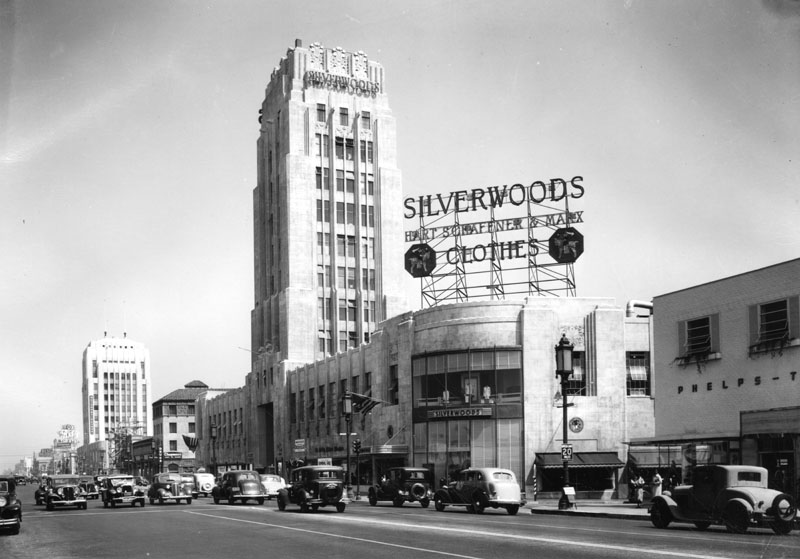Mid-Wilshire and the 'Miracle Mile' (1920s & 1930s)
Historical Photos of the Miracle Mile |
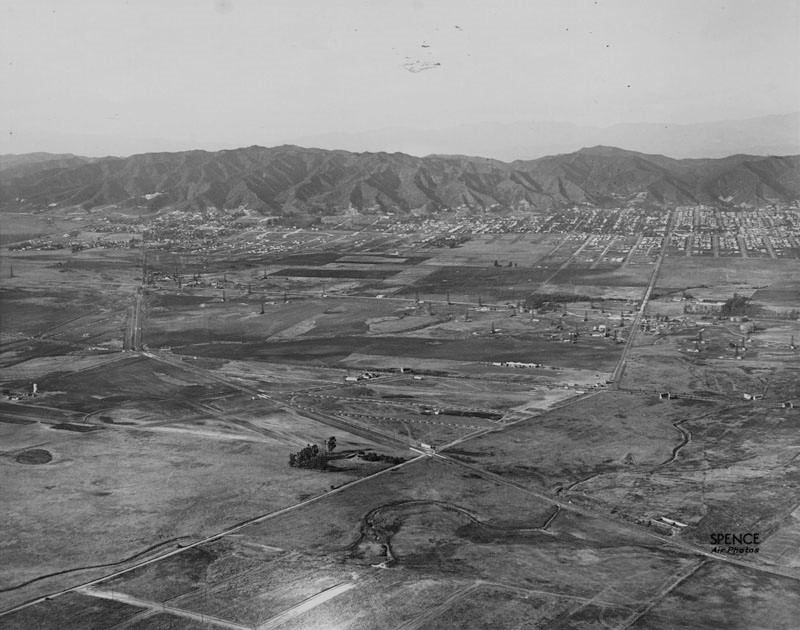 |
|
| (1922)^ - Aerial view looking northwesterly showing Crescent Ave (later Fairfax Ave) running diagonally from lower-left to center-right where it crosses Wilshire Boulevard (center-right) and makes a slight bend north towards the Hollywood Hills. San Vicente runs diagonally from lower-right to upper left and turns up toward West Hollywood. Note the oil wells scattered across the open land. |
Historical Notes In the early 1920s, the stretch of Wilshire Boulevard now known as the Miracle Mile was a 20-foot-wide dirt road, flanked by oil wells and barley fields. Today, the strip is a busy thoroughfare, home to museums, the La Brea Tar Pits, and a collection of historic Art Deco structures. |
Wilshire and Fairfax
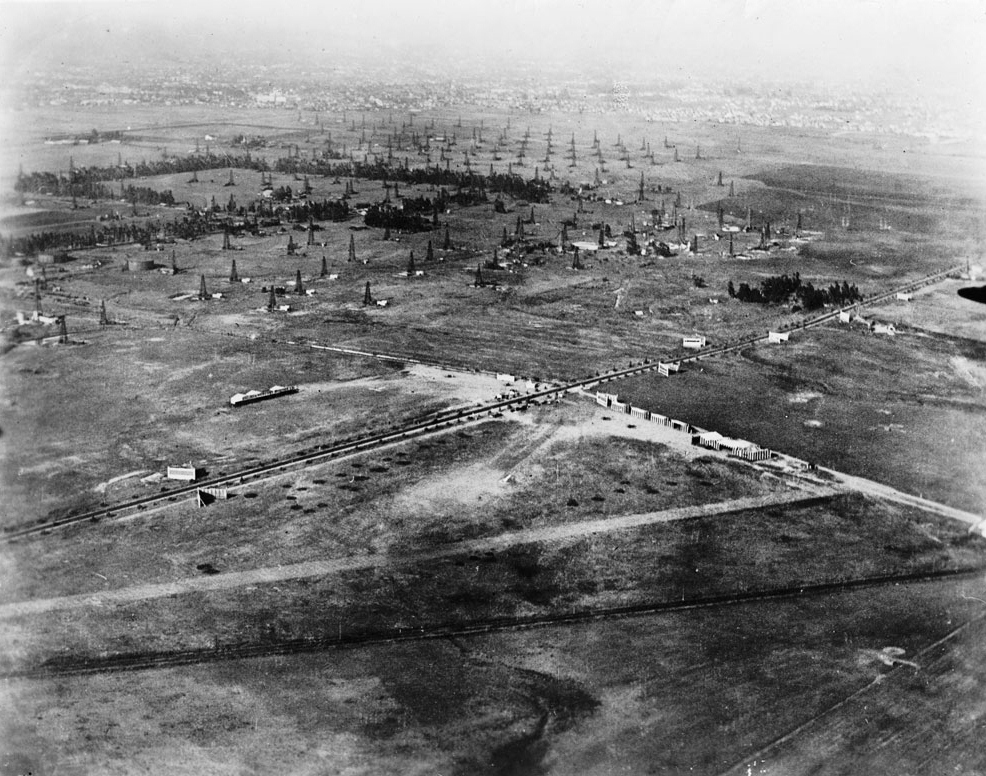 |
|
| (1920)^ - Aerial view of Crescent Avenue (now Fairfax) and Wilshire Boulevard in 1920 showing undeveloped land with many oil derricks. In the lower part of the photograph is Chaplin Airport. The tree-lined street is Wilshire. The diagonal line at the bottom is actually railroad tracks that would later become San Vicente Bouelvard. |
Historical Notes The Fairfax District was little more than bean fields at the turn of the century when Arthur Fremont Gilmore set out to dig a well on his 256-acre dairy farm near West 3rd Street in Fairfax Avenue. But instead of water, Gilmore struck oil. His discovery is credited with prompting an oil exploration boom in the area- later called the Salt Lake oil fields. Gilmore helped build the Fairfax area into one of the city’s best-known commercial areas (Farmers Market).+# Chaplin Airfield was located on leased property that is now bounded by Wilshire Boulevard, Fairfax Avenue, and San Vincente Boulevard. The Syd Chaplin Aircraft Corporation advertised that it “maintained a fleet of newest Curtis one and two-passenger aeroplanes, large shops with complete equipment and hangars for our own ships as well as those belonging to business firms and individuals.” Syd Chaplin was the brother of famed actor Charlie Chaplin. |
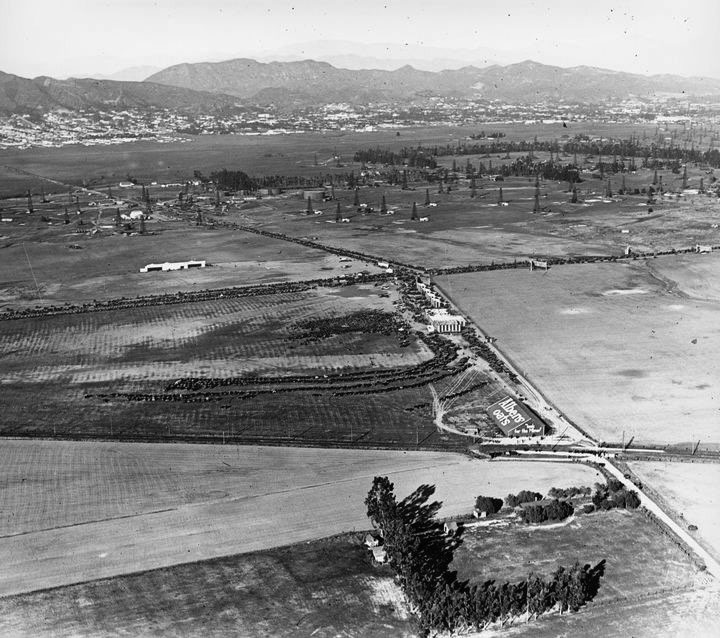 |
|
| (ca. 1922)^##* - View looking north shows numerous cars parked on a lot (center of photo) near the airfield as well as along Wilshire Blvd. and Crescent Ave (Fairfax). Large sign on building in the lower-right center at the intersection of Fairfax and the San Vicente line of the Pacific Electric Railway reads: Albers Oats. |
Historical Notes In the 1890s, dairy farmer Arthur F. Gilmore found oil on his land, probably in the vicinity of the La Brea Tar Pits. The field was named after the Salt Lake Oil Company, the first firm to arrive to drill in the area. The discovery well was spudded (started) in 1902. Development of the field was fast, as oil wells spread across the landscape, with drillers hoping to match the production boom taking place a few miles to the east at the Los Angeles City field. Peak production was in 1908. By 1912, there were 326 wells, 47 of which had already been abandoned, and by 1917 more than 450, which had by then produced more than 50 million barrels of oil. After this peak, production declined rapidly. Land values rose, corresponding to the fast growth of the adjacent city of Los Angeles, and the field was mostly idled in favor of housing and commercial development. The early wells were abandoned; many of their exact locations are not known, and are now covered with buildings and roads.^* |
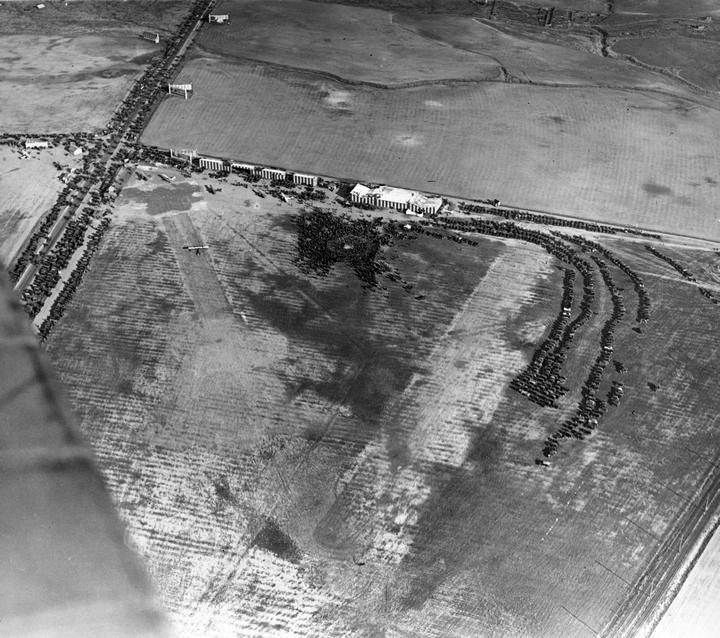 |
|
| (ca. 1922)^.^ – Aerial view looking down at the Chaplin Airdrome with the intersection of Crescent Ave (later renamed Fairfax Ave) and Wilshire Blvd. |
Historical Notes Chaplin Airfield was located on leased property that is now bounded by Wilshire Boulevard, Fairfax Avenue, and San Vincente Boulevard. The Syd Chaplin Aircraft Corporation advertised that it “maintained a fleet of newest Curtis one and two-passenger aeroplanes, large shops with complete equipment and hangars for our own ships as well as those belonging to business firms and individuals.” Syd Chaplin was the brother of famed actor Charlie Chaplin. |
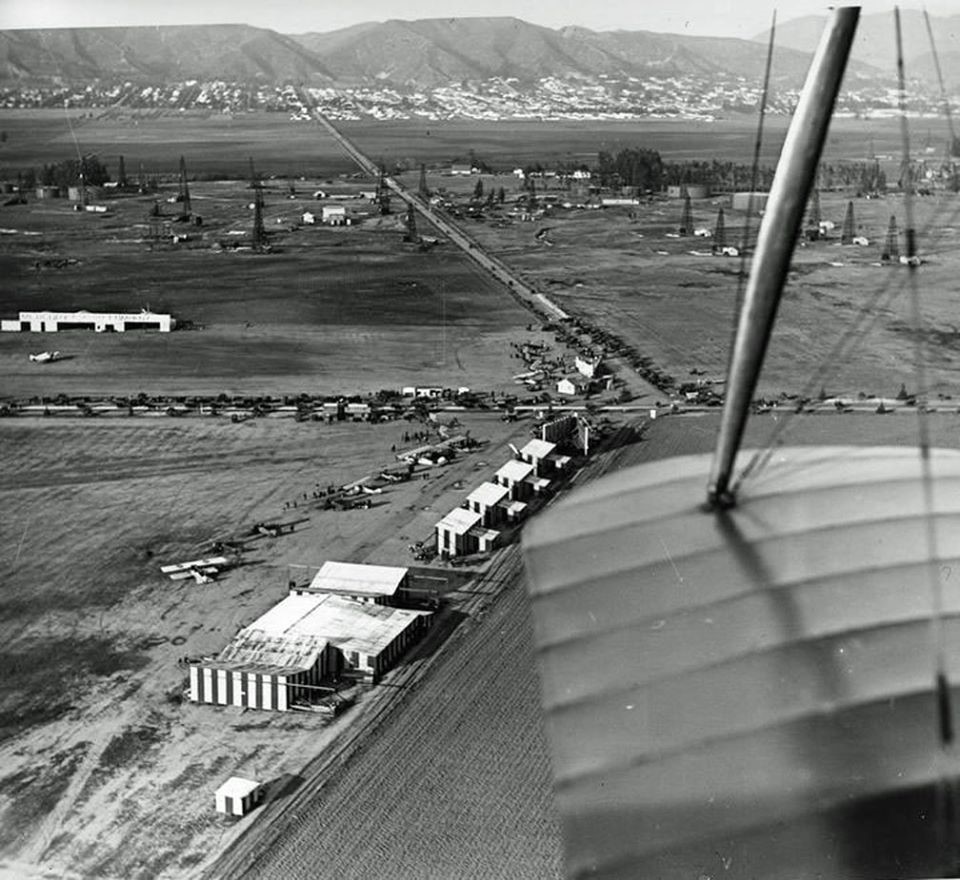 |
|
| (ca. 1922)^#^# - View looking north over the wing of a bi-plane showing the intersection of Crescent Ave (Fairfax) and Wilshire Blvd. A crowded airfield (now Rogers Airfield) is seen below. In the distance oil derricks are seen at Fairfax Avenue where 6th Street is located today. In the far background, at the foothills, can be seen a built-up Hollywood. |
Historical Notes By 1922 both Chaplin Airfield (S/W corner) and De Mille Field No. 2 (N/W corner) would be owned by Emery H. Rogers, owner of Rogers Aircraft Inc. They would be part of Rogers Airfield which straddled Wislhire Boulevard west of Farifax Avenue. Click HERE to see more in Aviation in Early Los Angels. |
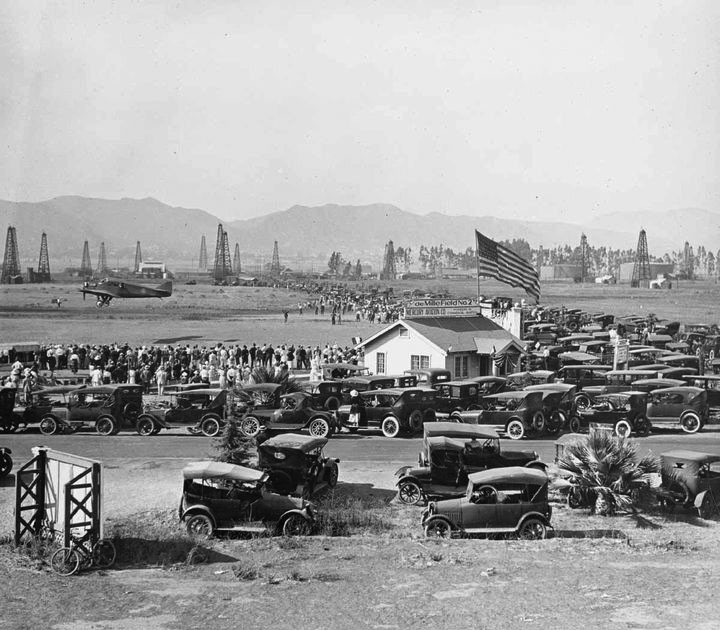 |
|
| (1920s)^#^# - Parking lot is full as crowds attend air show at DeMille Field No. 2. The sign on top of the structure with the large American Flag reads: DeMille Field No. 2. View is looking northeast near the NW corner of Wilshire and Fairfax. In the background can be seen oil derricks and on the right (out of view) are the La Brea Tar Pits. |
La Brea Tar Pits
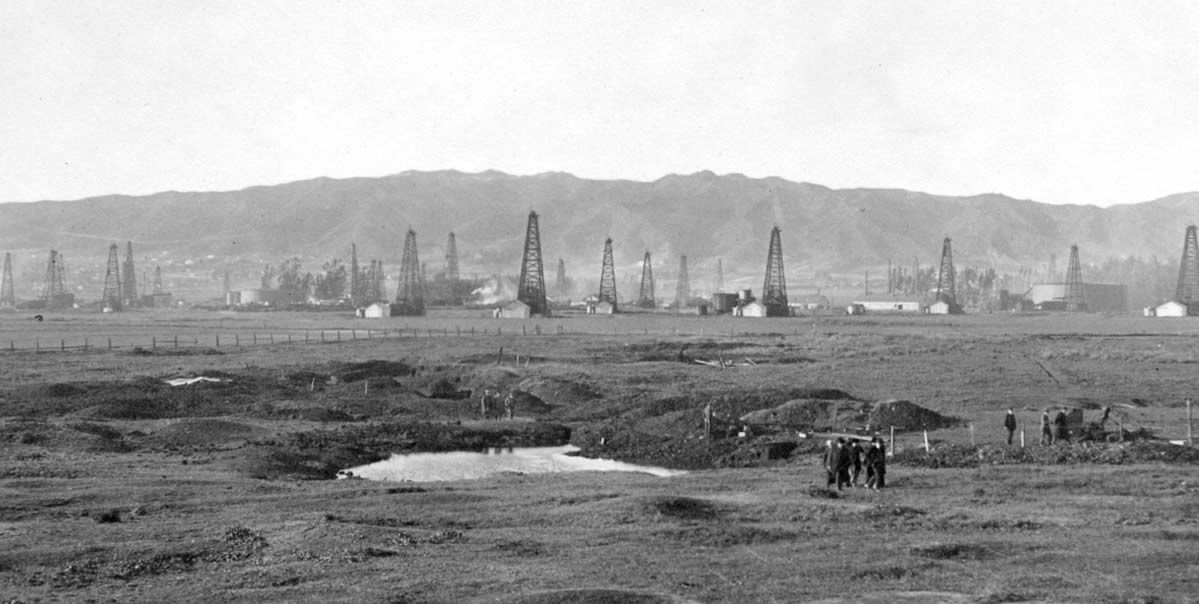 |
|
| (ca. 1910)* - View looking north from where Wilshire Boulevard is today, showing a group of men standing by a small pond of tar in an area known as La Brea Tar Pits, Hancock Park. Oil derricks belonging to the Hancock Family can be seen beyond the pond. Further north are some oil derricks belonging to A.F. Gilmore Oil Co. |
Historical Notes The La Brea Tar Pits are a group of tar pits around which Hancock Park was formed. Natural asphalt (also called asphaltum, bitumen, pitch or tar—brea in Spanish) has seeped up from the ground in this area for tens of thousands of years. Over many centuries, the bones of animals that were trapped in the tar were preserved. La Brea Avenue was named in 1869 with the Spanish word for tar, which was found in nearby pits and used for waterproofing the sod roofs of the adobe houses in the Plaza. The street was part of the 4,439-acre Rancho La Brea, which in 1860 was purchased by Maj. Henry Hancock for $2.50 an acre.^*^ |
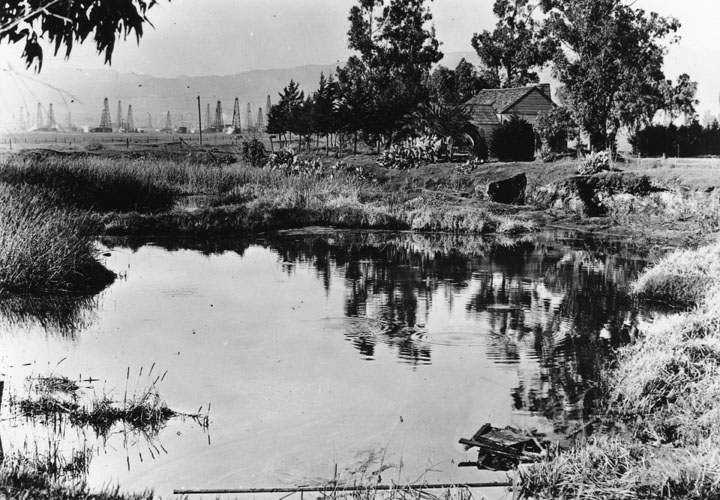 |
|
| (ca. 1910)^ - Standing on the edge of a small pond of tar we can look across it to the old Hancock Ranch House. Off to the left in the distance are the oil fields. Behind the camera is where Wilshire Boulevard is today. |
Historical Notes As a lawyer, Henry Hancock worked for the Rocha family to aid them with their efforts to prove their claim to Rancho La Brea. The Rochas finally won their claim, but like so many other rancheros, their legal expenses left them broke. In 1860 Jose Jorge Rocha, the son of Don Antonio Jose Rocha, deeded Rancho La Brea to Henry Hancock.*^ Hancock began to sell asphalt produced from the famous tar pits that gave the rancho its name. This was the beginning of the Hancock Oil Company. In 1885 Hancock’s widow leased part of the rancho to eastern oil men who went bust by 1888. But in 1902, Mrs. Hancock leased part of the rancho to the Salt Lake Oil Company, which proved a great success. Henry Hancock’s son, George A. Hancock, who had learned the oil business working for Salt Lake, established his own company in 1906. By February 1907, he had over 70 wells producing nearly 300 barrels a day, making the Hancocks one of California’s wealthiest families. The Hancock family built Hancock Park, a large upscale apartment community. The Hancock Oil Company was sold to Signal Oil in 1958. The 1965 Signal was sold to Humble, and both the Hancock and Signal brands vanished. |
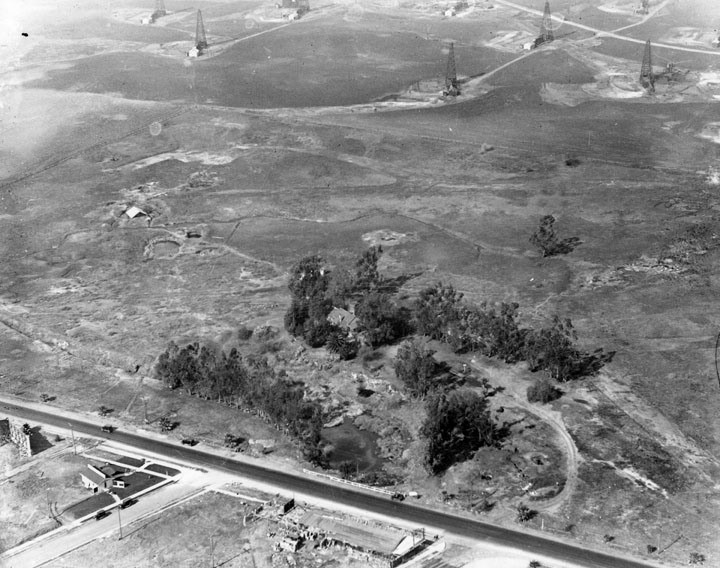 |
|
| (ca. 1920)^ - Aerial view of the La Brea tar pits and oil derricks. Seen from the air you have to look carefully at the foreground (across the road from the buildings) to see the pits among the trees, along with a building in the trees. A few pits can be seen in open area. At the top of the picture are a few of the derricks from the oil field. |
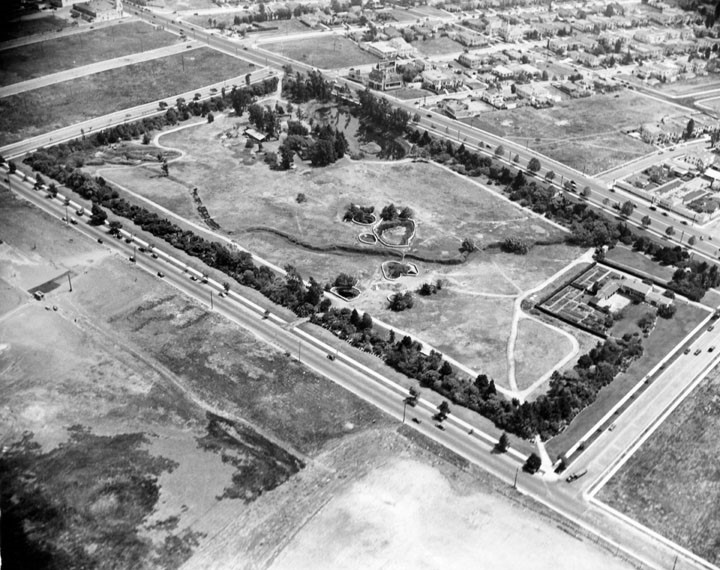 |
|
| (1924)^ – Aerial view looking southeast showing the La Brea Tar Pits and new housing development. Wilshire Boulevard runs diagonally at upper-right, Curson Ave is in the upper-left and 6th Street runs diagonally at bottom. |
Historical Notes After its peak (1908-1917), oil production declined rapidly. Land values rose, corresponding to the fast growth of the adjacent city of Los Angeles, and the field was mostly idled in favor of housing and commercial development. The early wells were abandoned; many of their exact locations are not known, and are now covered with buildings and roads.*^ |
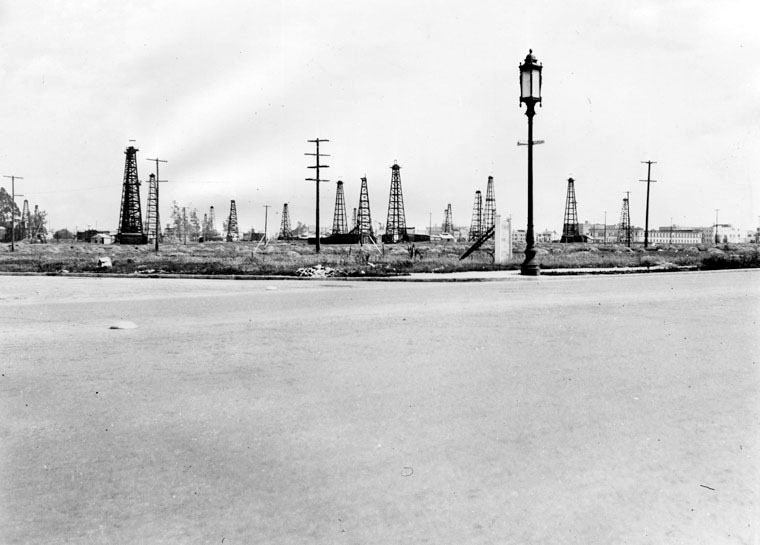 |
|
| (1930)^ - View of an oil field at the northeast corner of Wilshire Boulevard and Curson Avenue. Click HERE for contemporary view. |
Historical Notes The above corner would become the site of the Prudential Building, built in 1948. |
Then and Now
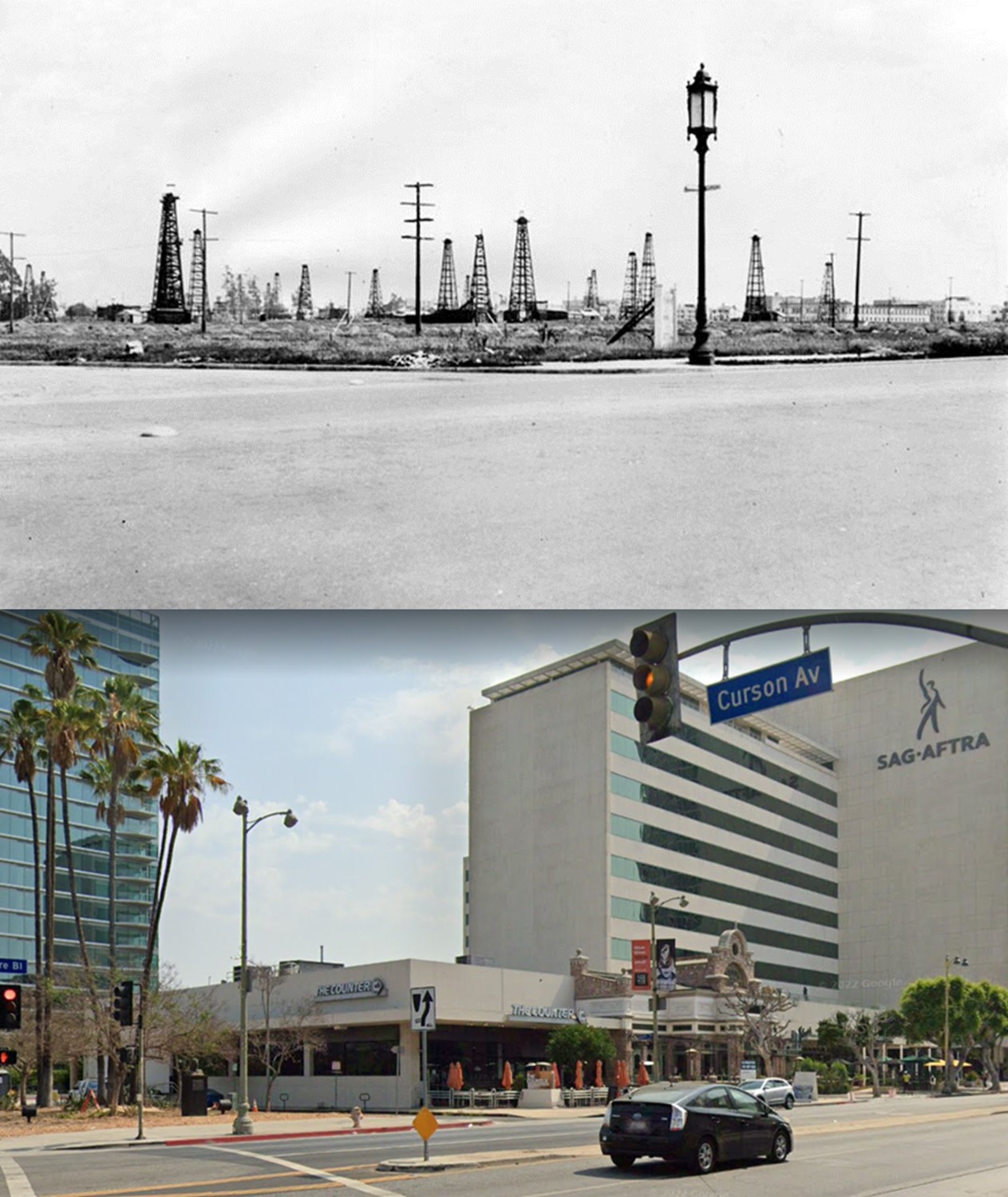 |
|
| (1930 vs 2021)* - Looking at the NE corner of Wishire and Curson. |
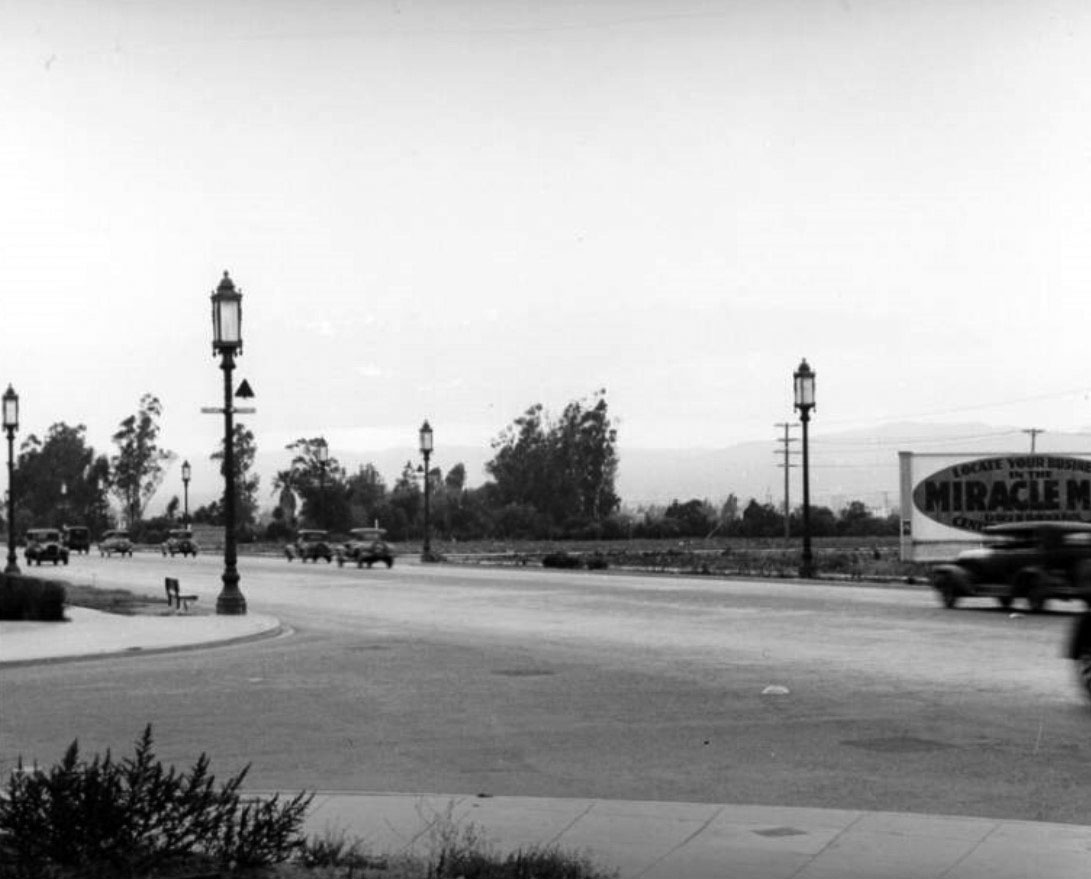 |
|
| (1930s)^ - A view of Wilshire Boulevard looking northwest across Masselin Avenue. A sign just barely in the picture on the right advertises for businesses to locate in the "Miracle Mile" on Wilshire Blvd. La Brea Tar Pits can be seen in the distance. |
Historical Notes In 1948, the Prudential Building would go up on the empty lot across Wilshire between the sign and the La Brea Tar Pits. Click HERE for a 1950 view of this same intersection. |
Then and Now
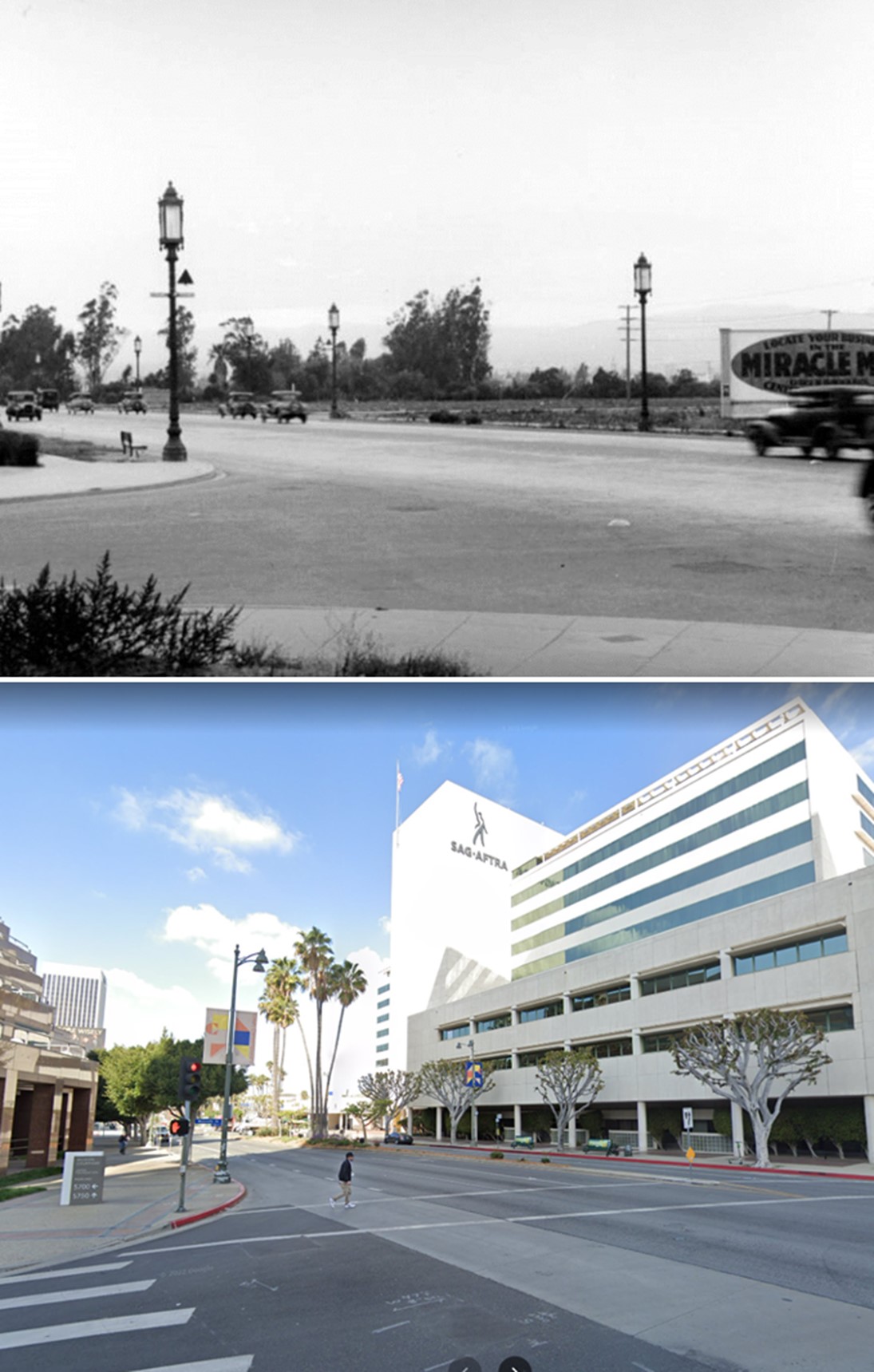 |
|
| (1930 vs 2021)* - Looking northwest from the intersection of Wilshire Boulevard and Masselin Avenue. |
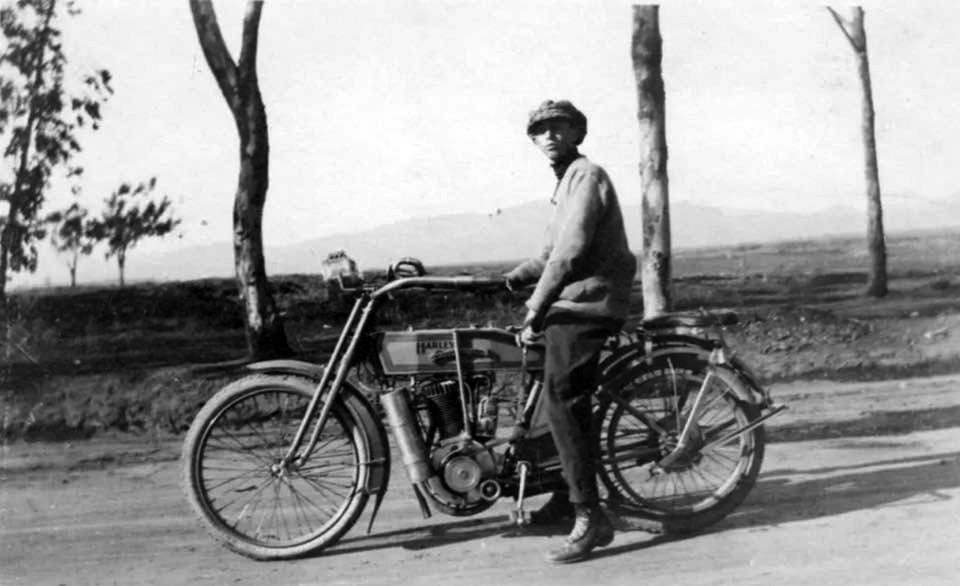 |
|
| (1910)^^^* - View looking north showing a young man sitting on his Harley on Wilshire Bouelvard with the Hollywood Hills in the distance. |
Historical Notes In 1903, William Harley and his childhood friend, Arthur Davidson founded Harley-Davidson, Inc. (H-D), or Harley, in Milwaukee, Wisconsin. Production in 1905 and 1906 were all single-cylinder models with 26.84 cubic inches engines. In February 1907 a prototype model with a 45-degree V-Twin engine was displayed at the Chicago Automobile Show. These first V-Twins displaced 53.68 cubic inches and produced about 7 horsepower. This gave about double the power of the first singles. Top speed was about 60 mph. Production jumped from 450 motorcycles in 1908 to 1,149 machines in 1909. Harley is one of two major American motorcycle manufacturers to survive the Great Depression (along with Indian)*^ |
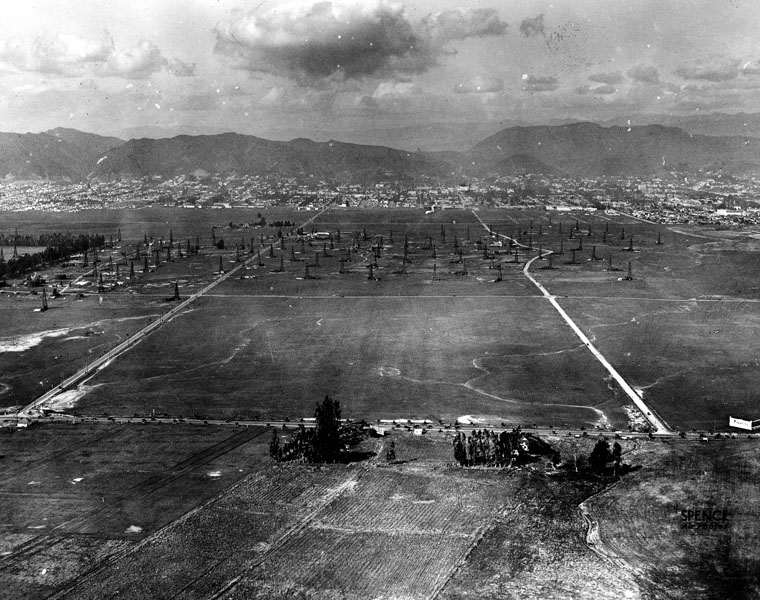 |
|
| (1922)^ - Aerial view looking north towards the Hollywood Hills from above Wilshire Boulevard near La Brea. Oil wells are seen throughout the area. |
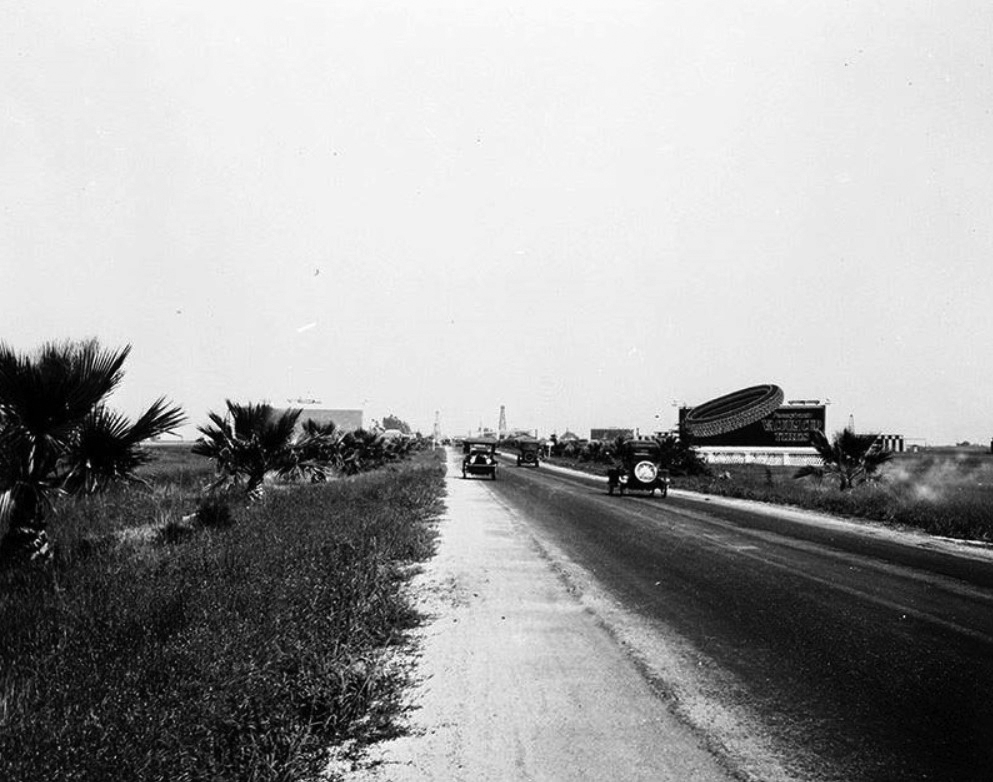 |
|
| (1920)^ – View looking east on a two-lane Wilshire Boulevard from near La Brea Avenue. Signboards, open fields, and oil derricks are about all you can see. This would become part of the Miracle Mile. |
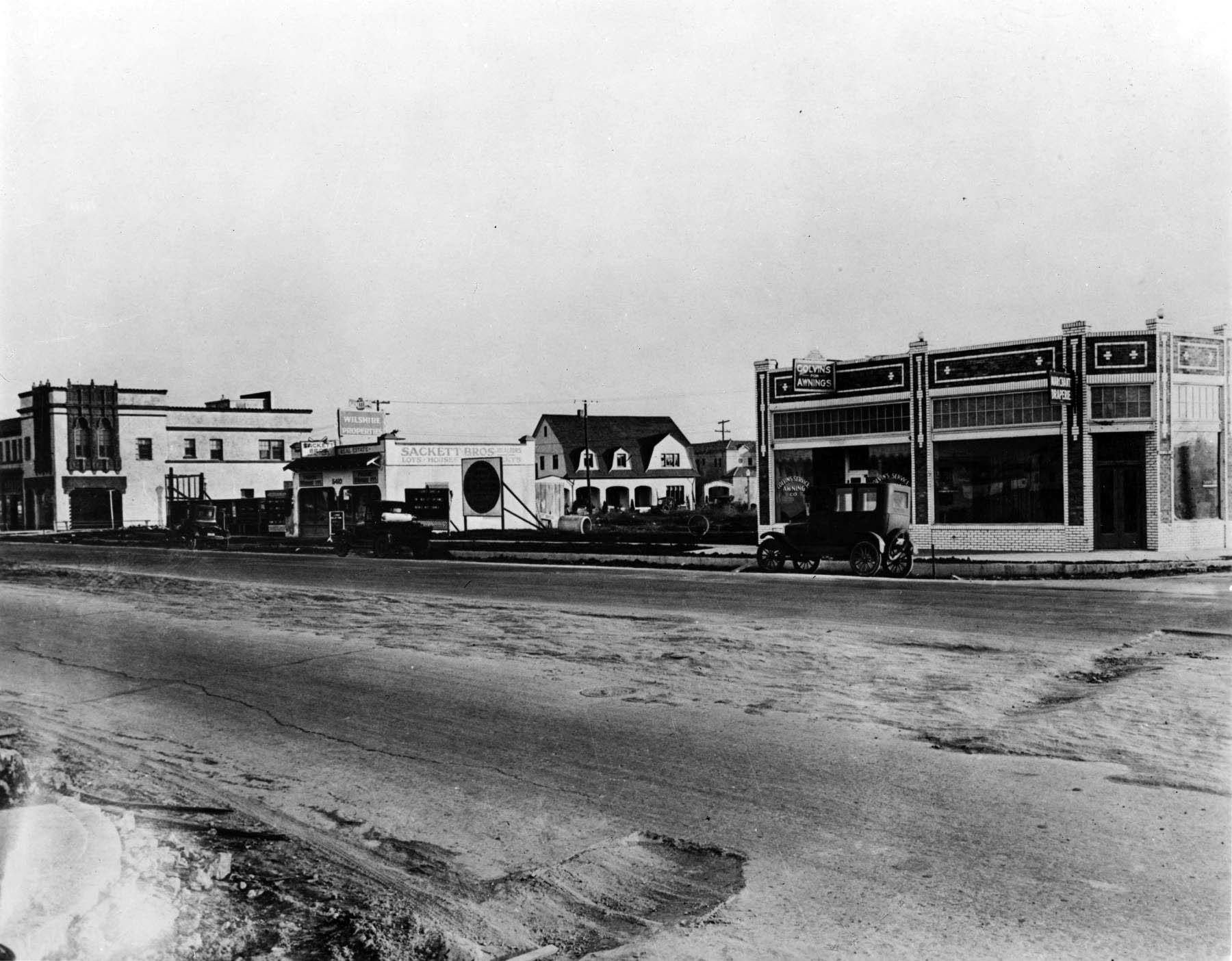 |
|
| (1920s)*# – View looking toward the south side of Wilshire Boulevard between Cloverdale Avenue and Cochran Avenue. The Dominguez-Wilshire Building (aka Myer Siegel & Co. Building) was constructed on this site in 1930. |
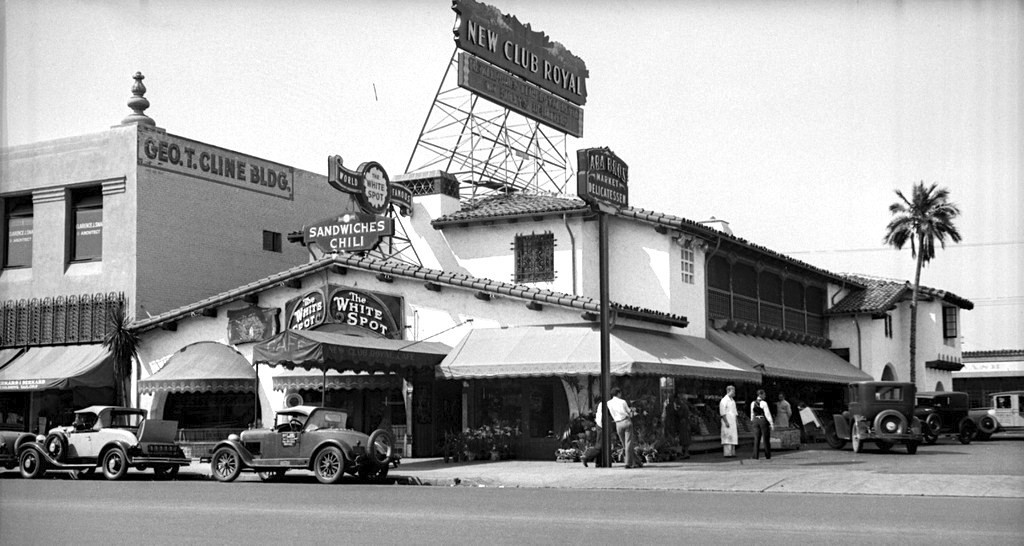 |
|
| (ca. 1928)^ – View showing the White Spot Café located at 5357 Wilshire Boulevard, north side of Wilshire between Cloverdale and Detroit. |
Historical Notes A popular 1920s eatery for teenagers. Though it closed around 1941, many old timers used to argue over which Los Angeles cafe first introduced the chili burger, the White Spot or Ptomaine Tommy’s. Chili burgers aside, the White Spot was famous in its day for their omelets smothered in chili. The cafe’s devoted following also used to drop in late at night for “midnight specials.” The name ‘White Spot’ was most likely derived from the nickname for the city itself: the “White Spot of America.” White Spot was a term embraced by city boosters based on maps produced by the US Chamber of Commerce in its magazine, The Nation’s Business. The maps illustrated business conditions in areas of the country shaded black (poor), white with black stripes (fair), and white (good). Los Angeles was a “white spot” in a sea of black and grey on the map in the early 1920s. Boosterism in LA was concentrated in the Chandler family dynasty that owned the LA Times, which took the “white spot” to be a validation of their own vision for the city’s development: The Times ballyhooed Los Angeles as “the White Spot of America,“ a city free of crime, corruption, communism, and by implication, non-white races. The LA Times had enormous influence on how that city developed, which was intensely anti-union and racially segregated in the early days. The term "white spot” typically referred to LA’s relative prosperity and low unemployment in such things as buy-local campaigns, but was also used in racial terms, such as a “keep the white spot white” drive to keep non-whites from moving into a white neighborhood.^ There was another White Spot Restaurant located at 5467 Wilshire Boulevard. |
Wilshire and La Brea
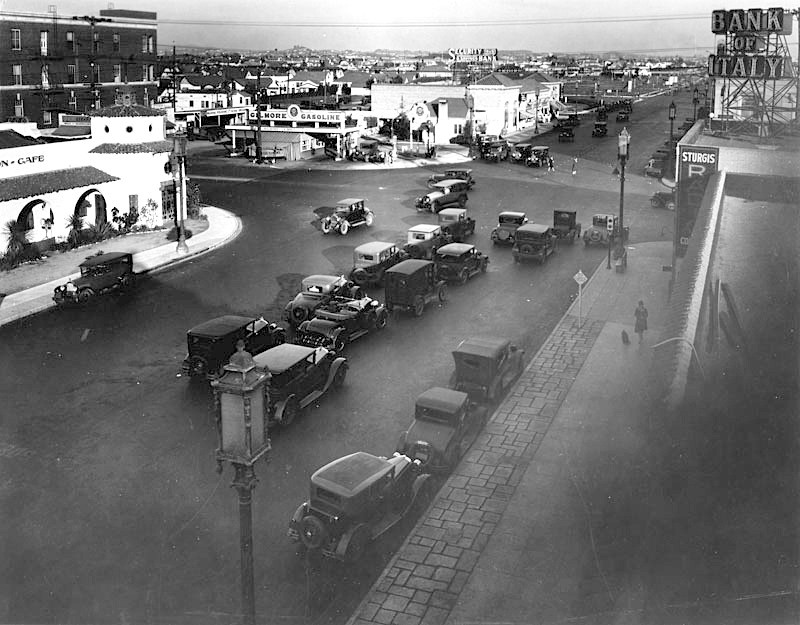 |
|
| (1928)^ – View looking east on Wilshire Boulevard toward La Brea Avenue. Note the Gilmore gas station on the northeast corner; the following year it would be demolished to make way for the E. Clem Wilson Building. The white building at upper left is the Dyas-Carleton Café, built in 1928. The Bank of Italy (sign upper right corner) would become the Bank of America. Below that sign is another sign that reads: Sturgis Radio Store. |
Historical Notes By the late 1920s, the intersection of Wilshire Boulevard and La Brea Avenue began to see significant commercial development. Developer A.W. Ross spearheaded efforts to transform Wilshire Boulevard into a commercial district that could compete with downtown Los Angeles. In 1928, a Gilmore gas station occupied the northeast corner of the intersection, while the Bank of Italy (later known as Bank of America) established a branch on another corner. The 1930s marked a period of rapid growth, with the area evolving into the renowned Miracle Mile. The E. Clem Wilson Building, constructed in 1929, replaced the Gilmore gas station on the northeast corner. By the mid-1930s, signs along Wilshire Boulevard proudly advertised the "Miracle Mile". During this time, the district's character shifted from primarily retail-oriented to increasingly office-based, solidifying its status as a key commercial hub in Los Angeles. |
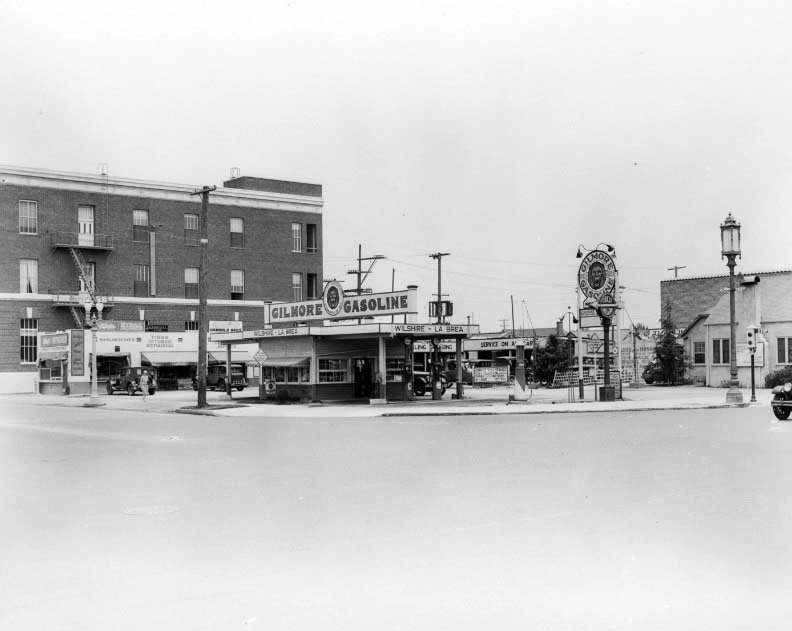 |
|
| (1928)* – View of the Gilmore gas station on the northeast corner of Wilshire Boulevard and La Brea Avenue. The brick building on the left is the telephone switching center. |
Historical Notes The gas station was demolished the following year to make way for the construction of the E. Clem Wilson Building. The brick-clad building facing La Brea Avenue in the left background housed an office and switching station for the Southern California Telephone Company, completed in 1925 to serve the city’s western neighborhoods. It was enlarged from three to five floors in 1942 and given a complementary Art Deco facade by architects John and Donald Parkinson. It continues to operate today under the ownership of AT&T. |
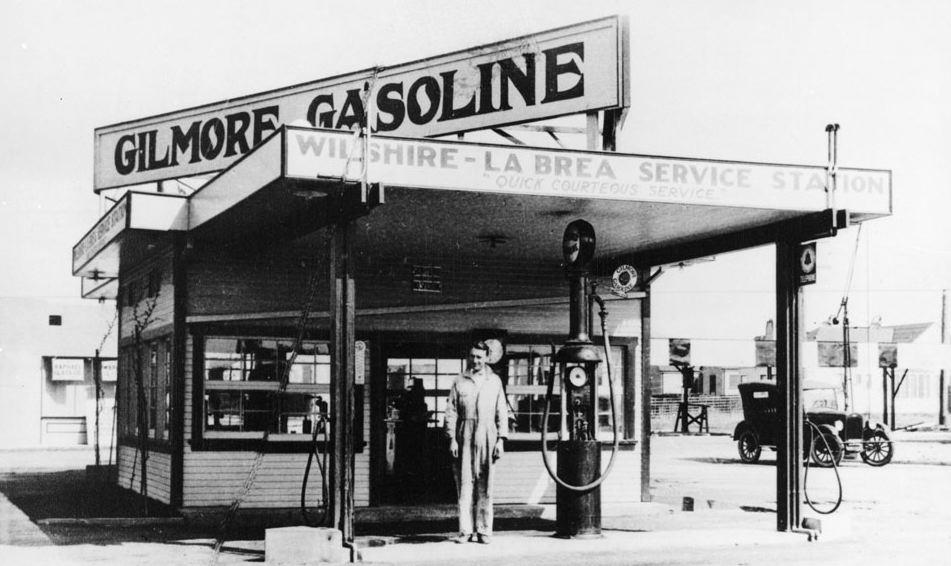 |
|
| (1920s)* - The Gilmore Gas Station was one of the first gas stations in Los Angeles. Located at the corner of La Brea and Wilshire Blvd. |
Historical Notes Today, you can find a replica of a gas station modeled after a 1936 era Gilmore Gas Station at Farmers Market. The 1936 replica and the one shown above are very similar. The station was put in place when the Grove Shopping Center was constructed adjacent to Farmers Market in 2002. Click HERE to see more Early Views of LA Gas Stations. |
.jpg) |
|
| (ca. 1929)^ - Looking west along Wilshire Boulevard at La Brea Avenue. The Ritz Theatre is on the left; on the right the Security-First National Bank Building (the first Art Deco structure on the Miracle Mile) is under construction. The The E. Clem Wilson Building (1930 - N/E corner of La Brea and Wilshire) has yet to be constructed. On the N/W corner can be seen the Dyas-Carleton Café. |
* * * * * |
Sturgis Radio Store
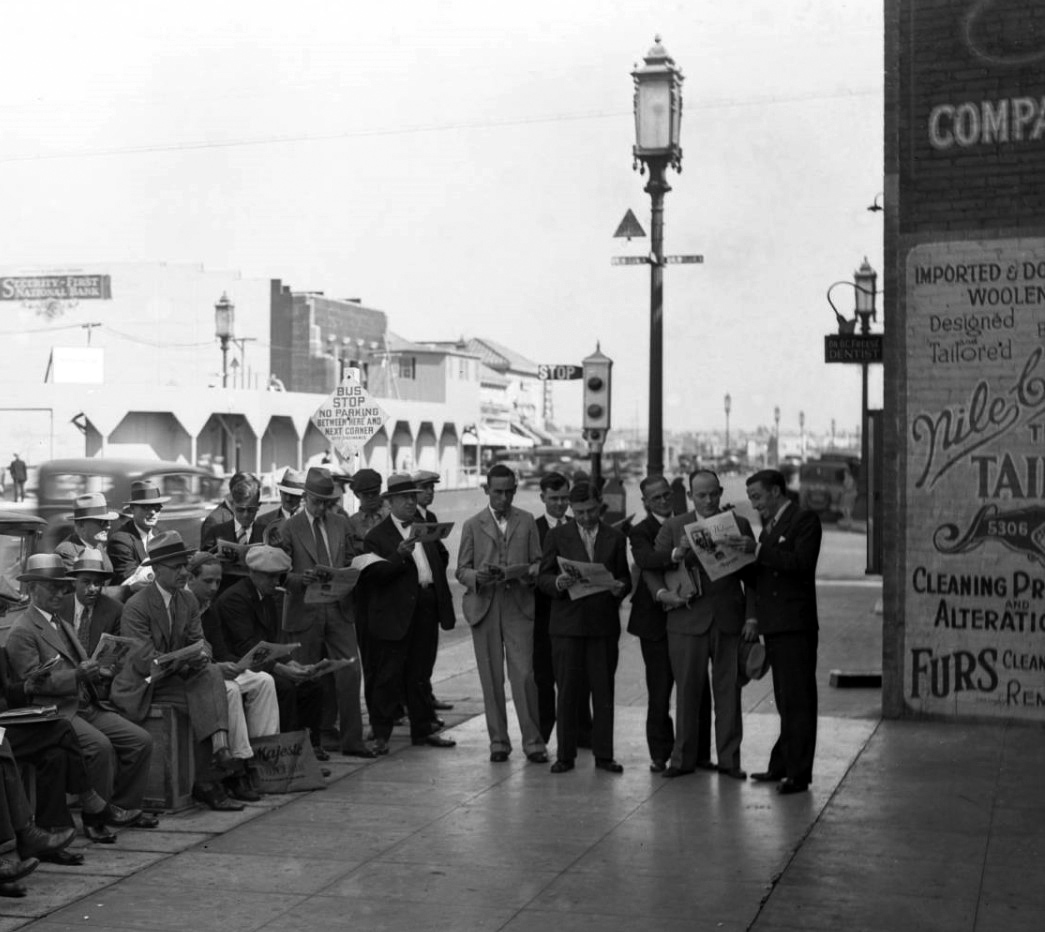 |
|
| (1929)* - A large group of men, most of whom are reading newspapers, are seen sitting and standing near the SW corner of Wilshire and La Brea. It turns out they are also listening to a live radio broadcast of the World Series in front of Sturgis Radio Store located to the right (out of view). Across the street on the NE corner can be seen the construction site for the new E. Clem Wilson Building where the Gilmore Gas Station once stood. The Art-Deco Security-First National Bank Building sits just to the east of there. Note the "Wilshire Special" streetlights and the Semaphore traffic signal on the corner. |
Historical Notes At this time, television was not yet available in homes, so radio served as the primary way families and communities shared news and entertainment. Crowds often gathered in public to listen together, creating a powerful sense of community. In the background, the northeast corner shows the construction of the E. Clem Wilson Building, which replaced the Gilmore Gas Station. To its east stood the Art-Deco Security-First National Bank Building. Also visible are “Wilshire Special” streetlights—ornate bronze posts installed in 1928, topped with lanterns guarded by four stylized, bare-breasted female figures—that became symbols of Wilshire Boulevard’s elegance. An early Semaphore traffic signal stands at the corner, reflecting the city’s first experiments in traffic management. This location is today the site of the Wilshire/La Brea Purple Line Metro station, scheduled to open in 2025. The northeast corner, once just a construction site, is now part of the commercial development that defines Los Angeles’ historic Miracle Mile. Click HERE for contemporary view. |
 |
|
| (1929)* - The crowd gathers outside the Sturgis Radio Store, listening intently to the live broadcast—many with newspapers in hand. |
Historical Notes The Athletics won the series in five games, highlighted by a dramatic Game 4 comeback when they scored 10 runs in the seventh inning after trailing 8-0. For fans, radio made it possible to experience this drama in real time. The moment demonstrates the cultural significance of radio in the 1920s. Televised sports were still years away—the first official Major League night game would not be played until 1935, and baseball itself would not arrive on the West Coast until 1958 when the Dodgers and Giants relocated. In 1929, radio was not just technology, but a social glue that brought neighbors and strangers together to share unforgettable experiences. |
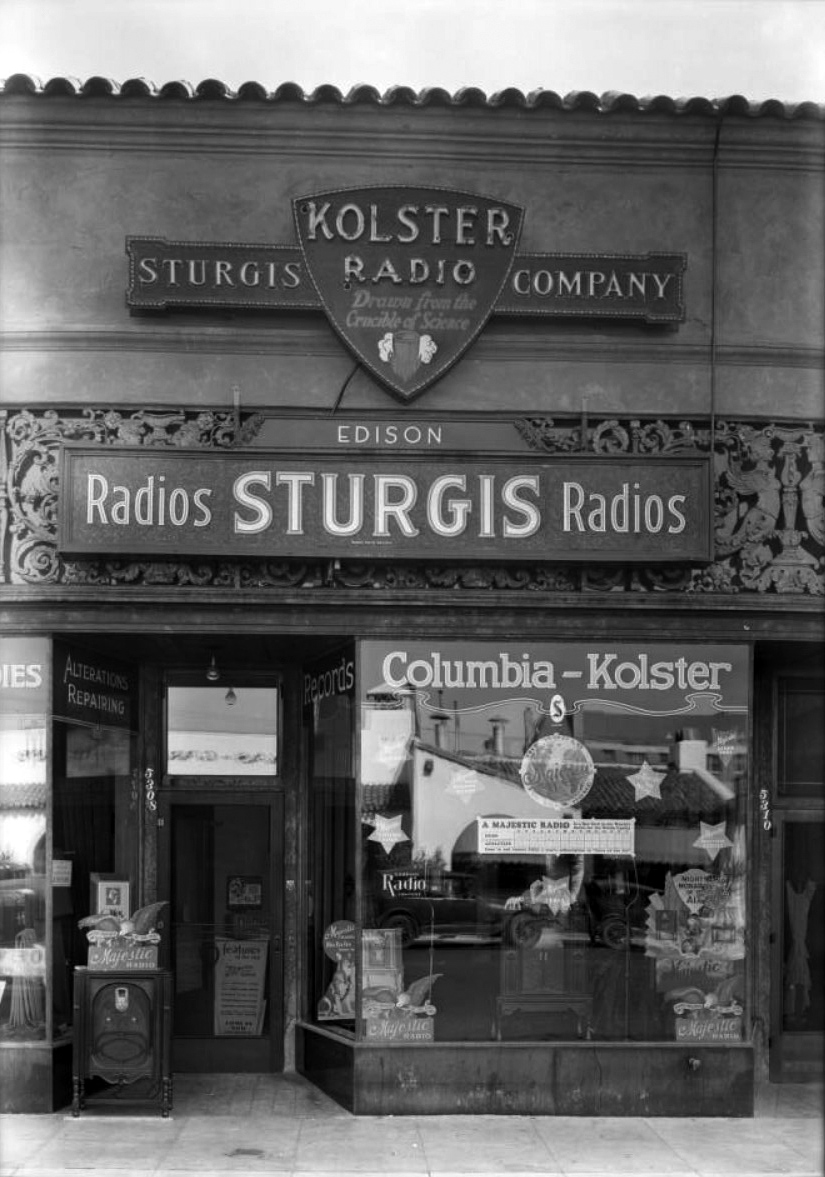 |
|
| (1929)* - Close-up view showing the front entrance to the Sturgis Radio Store at 5308 Wilshire Boulevard. A sign reads: “A Majestic Radio is a Box Seat to the World’s Series for the Whole Family, Cubs, Athletics, Come in and receive Free a year’s subscription to ‘Voice of the Air’. |
Historical Notes This marketing campaign reveals how radios were pitched not simply as gadgets, but as gateways to culture and entertainment. They promised families a way to enjoy major national events like the World Series from the comfort of their living rooms—something revolutionary in an era before television. The sign also reflects how businesses tied their promotions to current events, offering radios as both technological marvels and tools of togetherness. For many households, the purchase of a radio meant joining in a new, shared national culture built on sound waves. |
* * * * * |
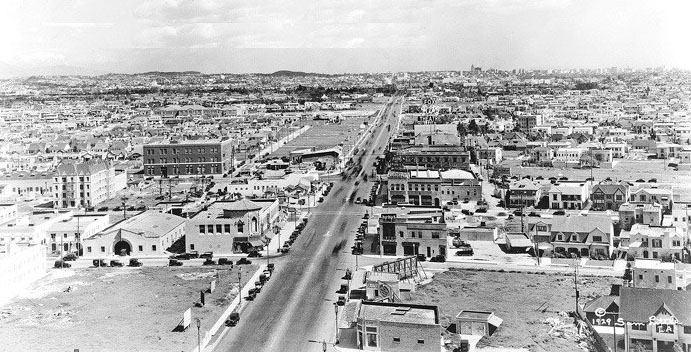 |
|
| (ca. 1929)^*# - View looking east along the Miracle Mile. The prominent brick structure (center-left) is the telephone switching center still is existence on La Brea Avenue just north of Wilshire. |
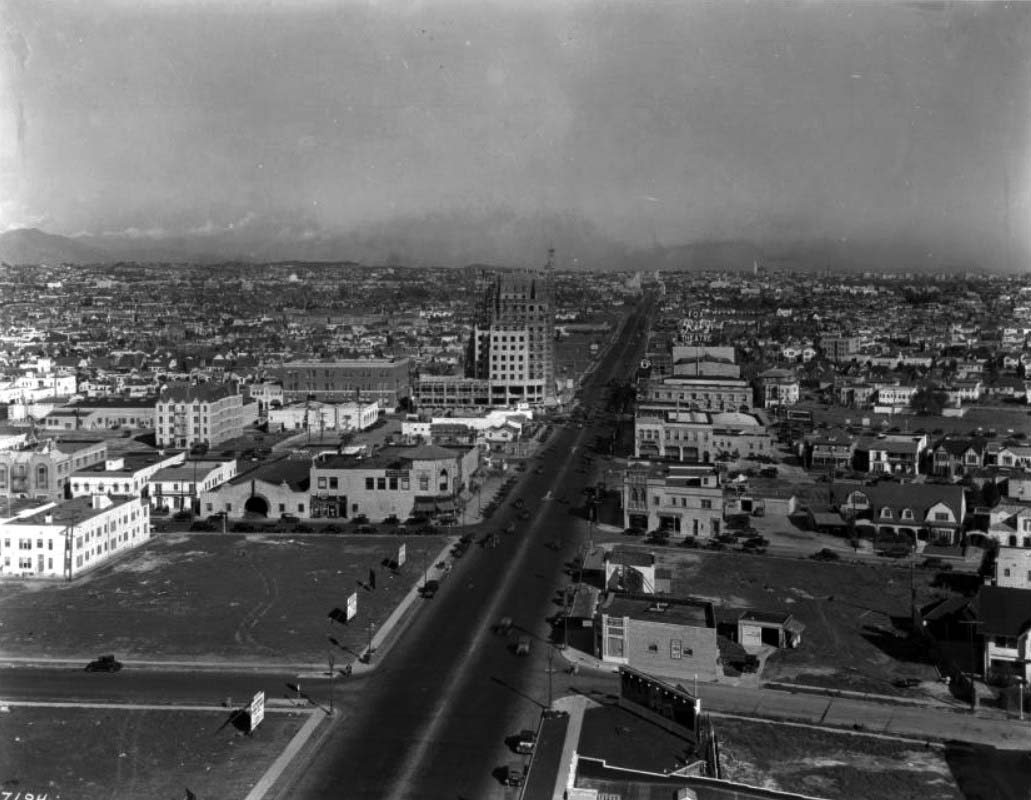 |
|
| (1930)* - View looking east on Wilshire Boulevard as seen from the top of the newly built Dominguez-Wilshire Building, between Cochran and Cloverdale Avenues. The E. Clem Wilson Building can be seen on the N/E corner of Wilshire and La Brea and appears to still be under construction. |
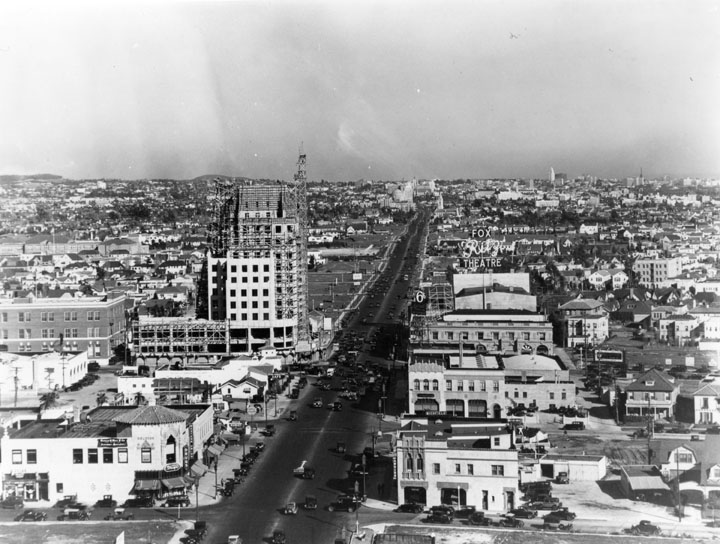 |
|
| (1930)^ - Wilshire Boulevard looking east from Tower Building west of La Brea in 1930. The Ritz Theatre is visible on the right. The new high rise E. Clem Wilson Building on the northeast corner of La Brea and Wilshire is under construction. |
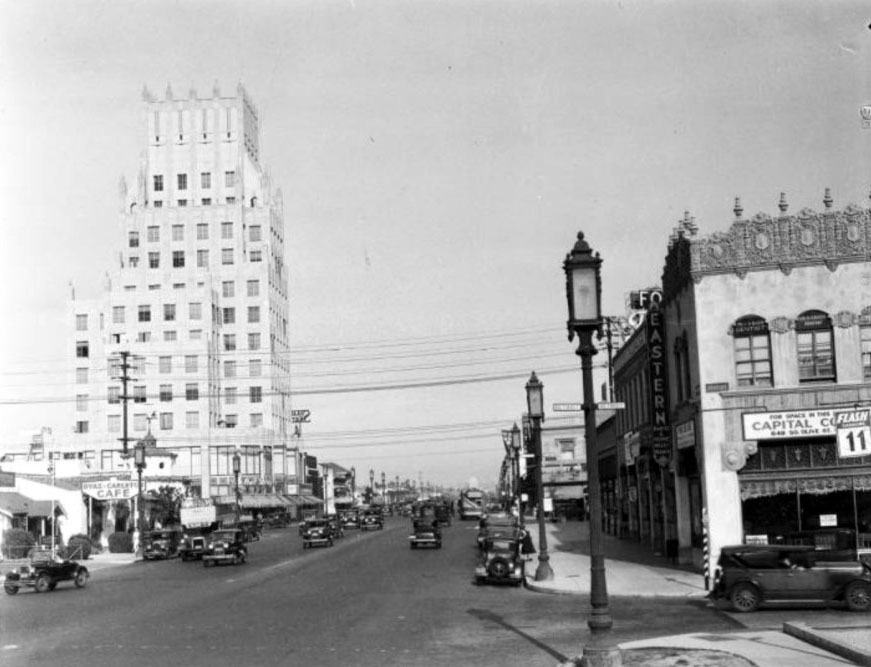 |
|
| (1932)* – View looking east on Wilshire Boulevard from Detroit Street. Ornate streetlight lanterns called “Wilshire Specials” line both sides of boulevard. The E. Clem Wilson Building is seen in the distance. |
E. Clem Wilson Building
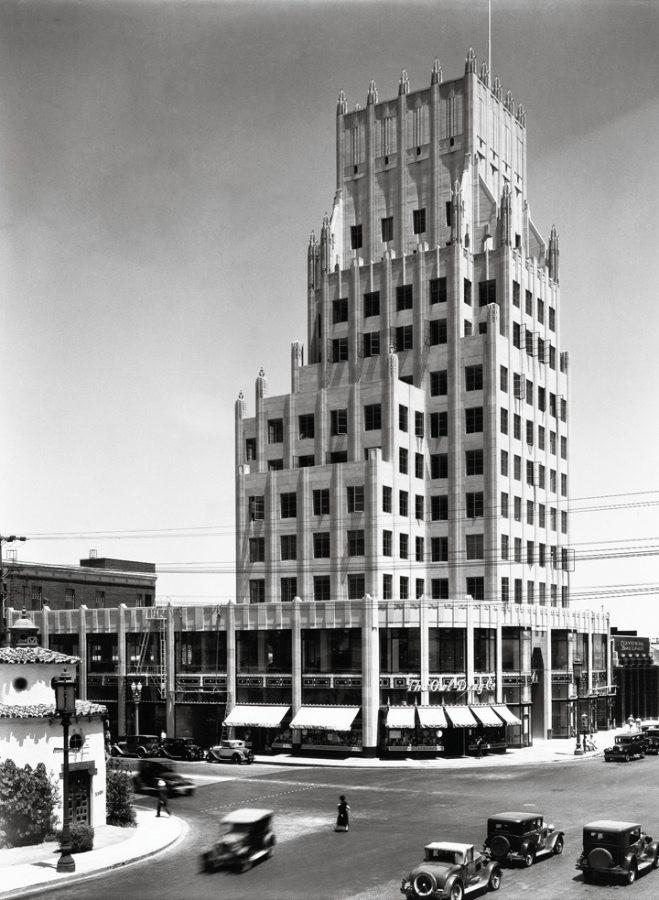 |
|
| (ca. 1930)*^^ - View of the intersection of Wilshire and La Brea. The new E. Clem Wilson Building is seen standing on the northeast corner. An Owl Drug store occupies the ground floor on the corner. |
Historical Notes Built in 1929 - 1930, the E. Clem Wilson Building was designed by architects Meyer and Holler in Art Deco (Zigzag) Moderne style. It is also known as the Wilson Building. Corporate names that adorned the Wilson Building included (in chronological order): General Insurance, Mutural of Omaha (until 1990), Asashi, and Samsung.^ |
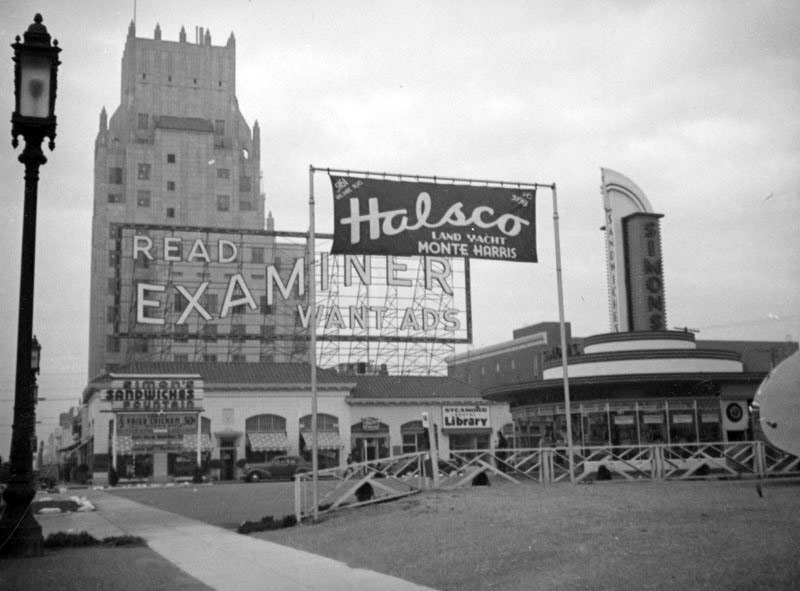 |
|
| (ca. 1939)^ - View showing the Simon’s drive-in restaurant, located at 5171 Wilshire Boulevard, with a sign for Halsco out front on the lawn. Nearby are a sign which encourages passers-by to “Read Examiner Want Ads,” the offices for Mutual of Omaha in the E. Clem Wilson Building (upper left, later Samsung), located at 5217 Wilshire Boulevard, and two Wilshire Lanterns (left). |
Historical Notes At one time Simon's Drive-Ins dominated the Southern California drive-in restaurant craze. The Simon brothers had operated a chain of successful dairy lunch counters in downtown Los Angeles, and in 1935 decided to capitalize on the growing car culture of Los Angeles by opening auto friendly locations in the emerging commercial centers of Wilshire Boulevard, Sunset and Ventura Boulevards. #^* Click HERE to see more Early Views of LA Drive-in Restaurants. |
Fox Ritz Theatre
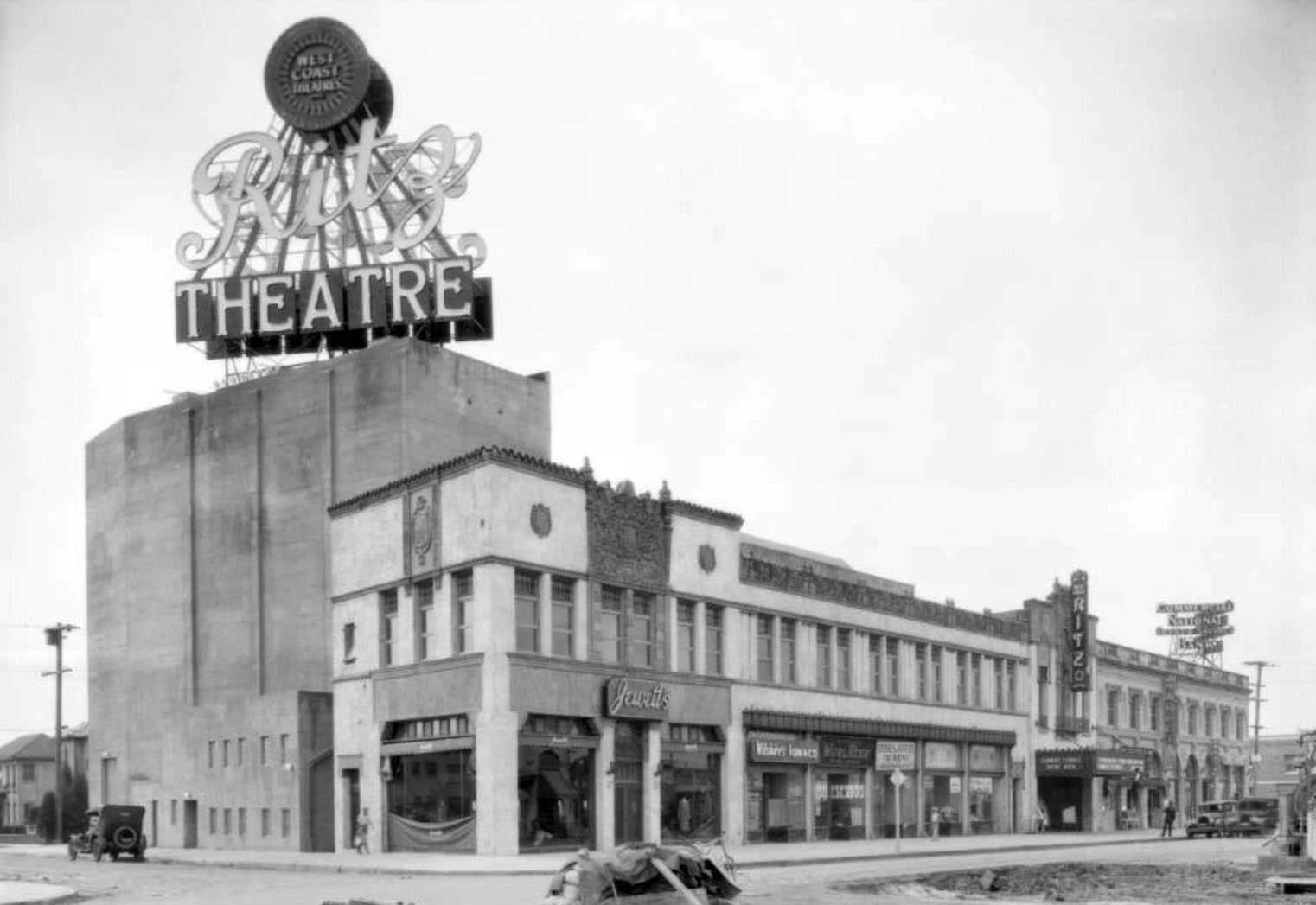 |
|
| (1926)^ – View looking at the southwest corner of Wilshire and Sycamore showing the Ritz Theatre. Opened in 1926, it joined the Fox theatre chain soon thereafter. The theatre building was on the south side of Wilshire and occupied the block between La Brea and Sycamore. |
Historical Notes The Fox Ritz Theatre at 5214 Wilshire Boulevard (S/E corner of Wilshire and La Brea) was designed by architect Lewis A. Smith. The 1600-seat theatre opened in 1926 and was demolished in 1977.^ |
 |
|
| (1931)^ – View showing the intersection of Wilshire Boulevard and La Brea Avenue with the Fox Ritz Theatre on the southeast corner. Note the double-decker bus on the left. |
Los Angeles Motor Bus Co.
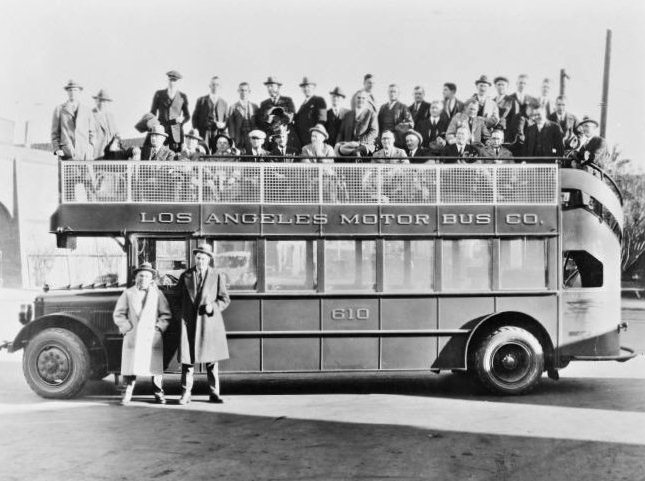 |
|
| (ca. 1920s)^## - This double-decker bus no. 610 was part of the Los Angeles Motor Bus line, built by Fageol in 1924. |
Historical Notes Los Angeles Motor Bus (later renamed the Los Angeles Motor Coach Company) was a joint venture of Pacific Electric and Los Angeles Railway that existed from 1923 until 1949. It began in 1923 as Wilshire Boulevard's transit service from the MacArthur Park area to La Brea Avenue and was extended further down Wilshire as the service gained in popularity. Wilshire has an interesting distinction, it was the only street that was banned by the City of Los Angeles from having street rail on it. The elites of early 20th century Los Angeles who built their mansions in the area were the region's first "NIMFYs" (Not in My Front Yard). The clanging bells and masses who rode streetcars were not welcomed on Wilshire, but buses were.^## |
Dominguez-Wilshire Building (aka Myer Siegel Building)
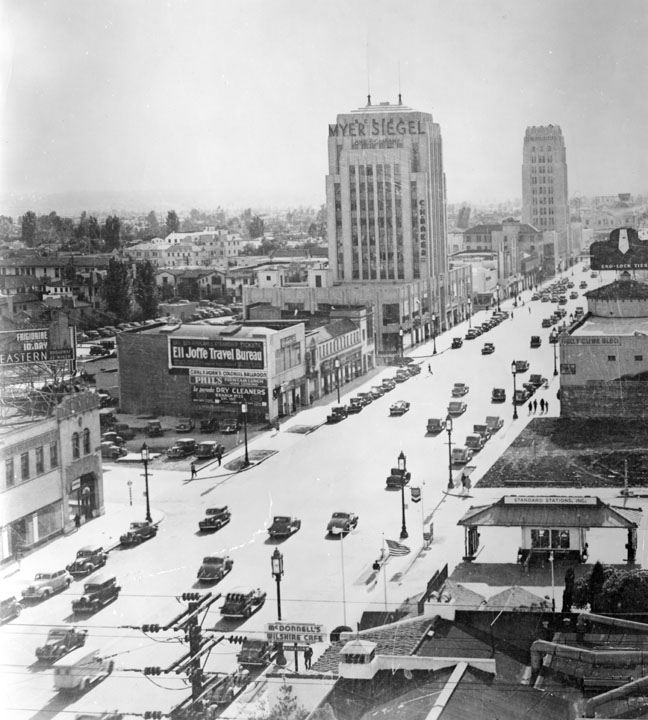 |
|
| (1932)^ - An overview of Wilshire Boulevard, looking west. Visible on the left side of the picture is a high rise building labeled Myer Siegel and Company (the Dominguez Building) with C.H. Baker on the front right lower portion of the exterior. Farther back on the street is Wilshire Tower with the name Desmonds just visible on the top. On the right side near the bottom of the picture is McDonnell's Wilshire Cafe and past it a Standard Oil gas station. |
Historical Notes The Dominguez-Wilshire building (also called the Myer-Siegel Building) was designed in 1930 by architects Morgan Walls and Clemens. The property was named after its developers, the Dominguez family, the heirs to the first land grant given in California by King Carlos III of Spain.*^ |
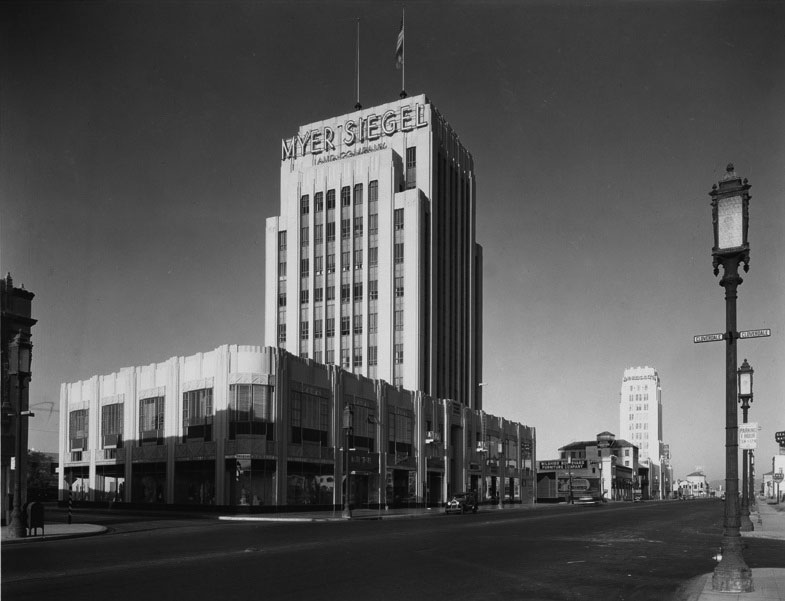 |
|
| (1931)^*# - Exterior view of the Dominguez-Wilshire Building (also known as the Myer Siegel Building), located at 5410 Wilshire Boulevard in the Miracle Mile district. The Wilshire Tower Building can be seen in the background. |
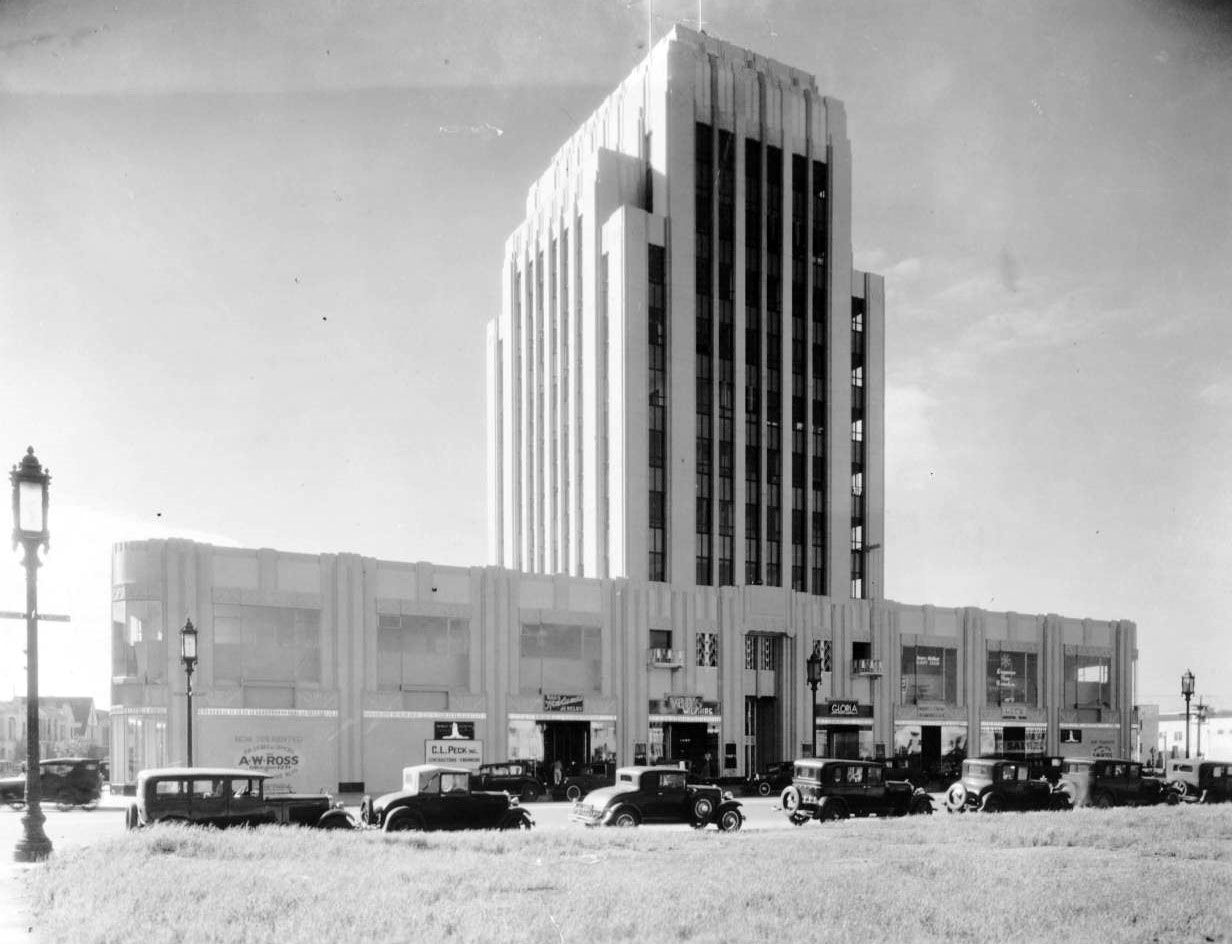 |
|
| (1931)^^ – View showing the Dominguez Wilshire Building, 5410 Wilshire Boulevard, shortly after opening as seen from an empty lot across the street. ; photograph dated 1931. Signs on the street level facade identify the leasing agent as A. W. Ross (the creator of the Miracle Mile). The signs also tout that the building is 75% rented. |
Historical Notes The same setup was used in the Wilshire Tower, two blocks west, with the symmetrical facade facing Wilshire Blvd, rounded corners on the intersections, and a parking lot with an entrance around the back. The 10 stories don't rise as high as the Wilshire Tower, but the building does make a statement among the other low rises along Wilshire Boulevard.*^*# |
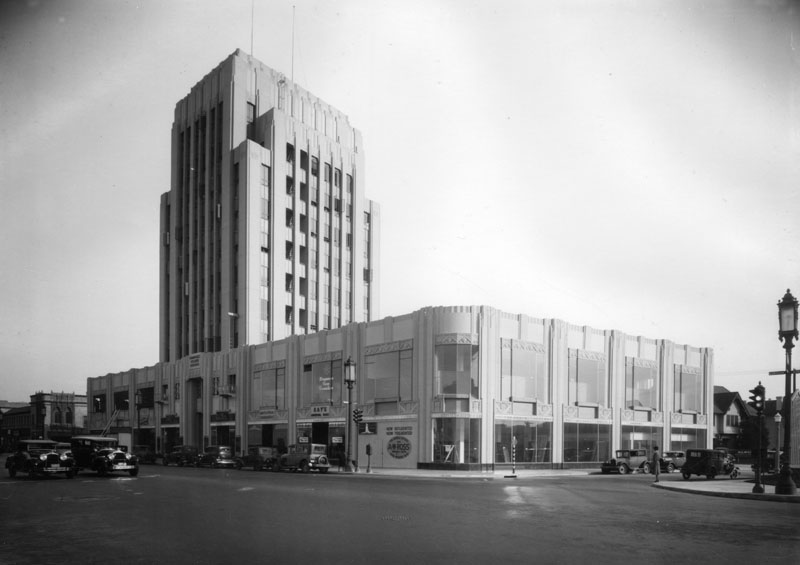 |
|
| (1930s)^*# - View looking at the SE corner of Wilshire Boulevard and Cochran Avenue showing the Dominguez Wilshire Builidng. Click HERE to see contemporary view. |
Historical Notes Zigzag motifs and a main automobile entrance at the rear defined this Art Deco office tower, the second built on the Miracle Mile after the Wilshire Tower (Gilbert Stanley Underwood, 1929) at 5514 Wilshire. The building's lower floors were leased by Myer Siegel, a women's clothing store known for showing the latest fashions from Paris.^ |
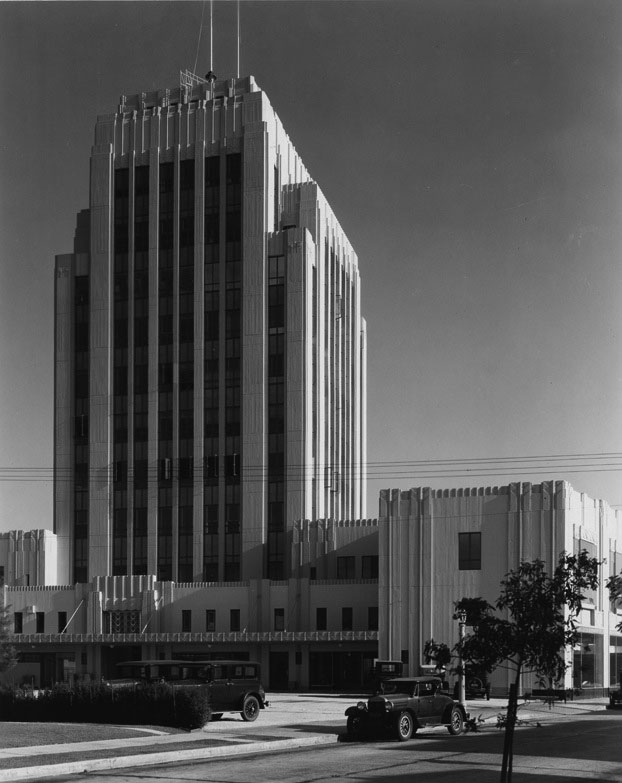 |
|
| (1931)^*# - Rear view of the Dominguez-Wilshire Building (Myer Siegel Building) from across Cloverdale Avenue with a partial view of the parking lot and the rear entrance. |
Historical Notes The building consists of an eight-story Art Deco tower placed on a two-story base. |
Wilshire Tower (aka Desmonds Building)
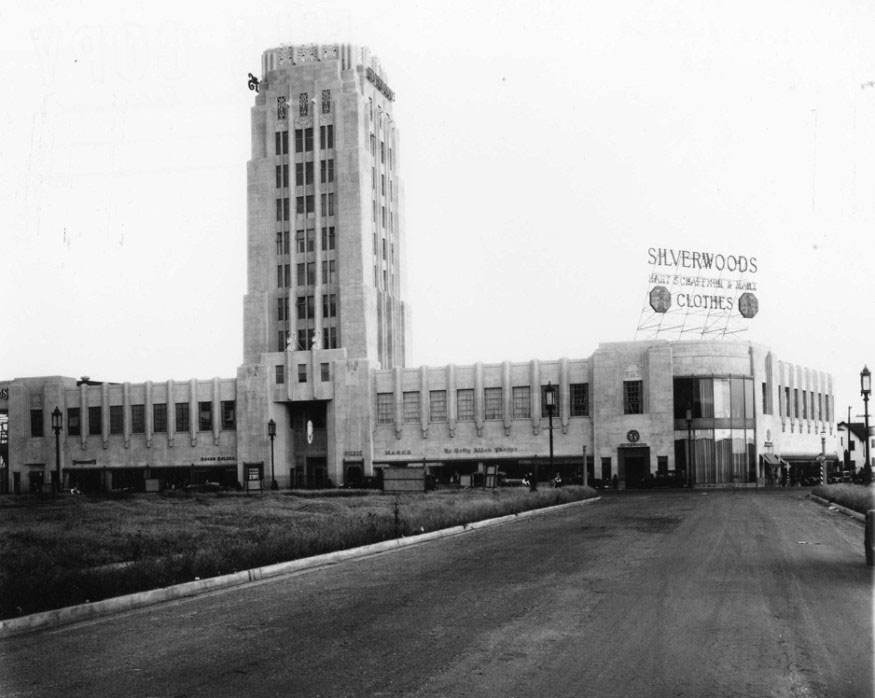 |
|
| (1929)^^ – View looking south along an unpaved Burnside Avenue at the Wilshire Tower on Wilshire Blvd. |
Historical Notes When it opened on March 15, 1929, the Wilshire Tower fronted an entire city block and featured an 11-story Art Deco tower. Desmond's main entrance opened onto the sidewalk, but many shoppers entered through the rear; in a nod to the automobile's ascendency, the store's owners built a large parking lot behind the store and reserved additional space for future parking needs. Other retailers soon followed Desmond's to the Miracle Mile, and they, too, provided ample parking for their customers behind their buildings. Silverwood's arrived in September 1929.* |
 |
|
| (1929)^ - View looking southwest showing Desmond's Clothing Store in the Wilshire Tower on the Miracle Mile, 5514 Wilshire Blvd. |
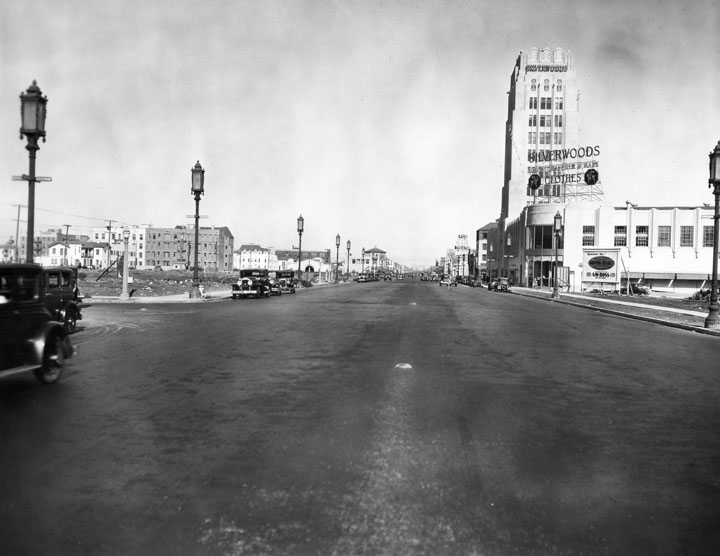 |
|
| (1929)^ - Ridgeley Drive and Wilshire Boulevard, showing the Wilshire Tower with Silverwoods on the ground floor. |
Historical Notes Wilshire Tower was the first Art Deco landmark tower on the street. Over the years stores such as Desmond's and Silverwoods occupied the ground floor while doctors and dentists had offices in the eight-story tower. Located at 5514 Wilshire Boulevard, the Zig-Zag Moderne building was designed by architect Gilbert Stanley Underwood and built in 1928.^ Note the ornate streetlights on Wilshire Boulevard, often referred to as 'Wilshire Specials'. |
Then and Now
 |
|
| (1929 vs 2022)* - Looking east on Wilshire from near Ridgely Drive. |
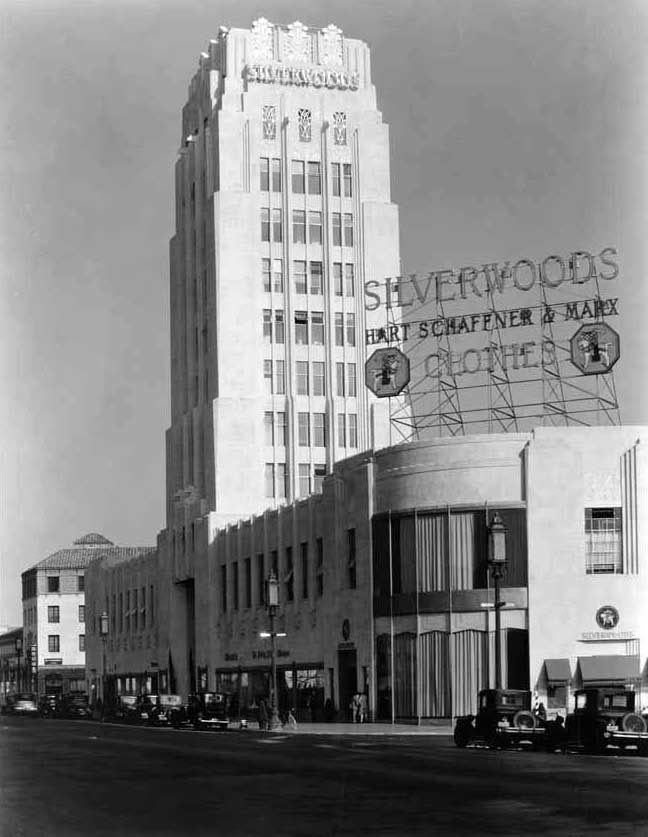 |
|
| (ca. 1930)^*# - Close-up view of the Wilshire Tower Building. The Silverwood's sign uppears both on the face of the top of the tower as well as on the roof of the store on the southeast corner of Wilshire and Burnside. |
Historical Notes Silverwood's was founded in 1894 by Francis Bernard ("Daddy") Silverwood, Los Angeles clothier, merchant, and businessman, originally from Canada, near Lindsay, Ontario. The first store was located at 124 South Spring St. in Los Angeles, and soon moved to larger quarters at 221 South Spring St. The flagship store was established in 1904 at Sixth & Broadway in downtown Los Angeles. Hartmarx, one of the nation's largest clothing manufacturers and retailers, bought Silverwood's in 1941 and kept thee name. The Silverwood's chain of clothing stores folded in the 1990s.^* |
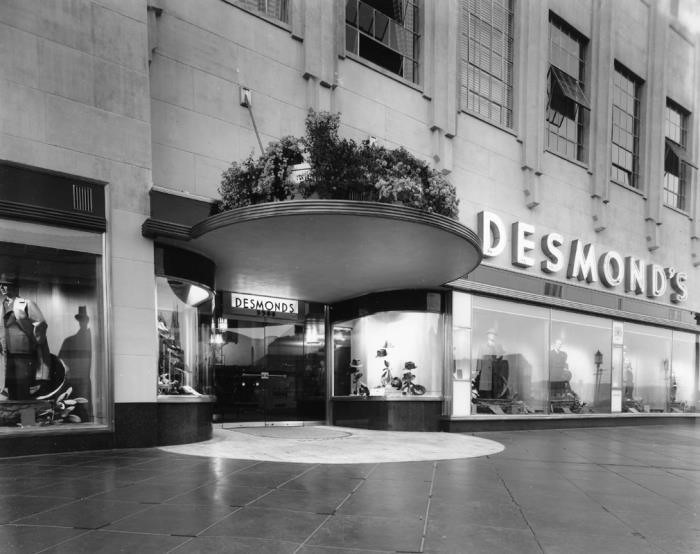 |
|
| (ca. 1939)+^^ – View showing the entrance to the Desmond’s store located in the Wilshire Tower Building. Note the huge window displays. |
Historical Notes Desmond’s was the first major clothing retailer on the Miracle Mile when it opened in 1929. Its main entrance opened onto the sidewalk, but many shoppers entered through the rear; in a nod to the automobile's ascendency, the store's owners built a large parking lot behind the store and reserved additional space for future parking needs. The first Desmond's Department Store was opened on Olvera Street in 1862. In 1921, Ralph R. Huesman purchased the store from the Desmond family and led the expansion of the retailer to several locations throughout the Southern California market. |
Historical Notes The historic Art Deco Wilshire Tower was designed by architect Gilbert Stanley Underwood and built in 1928-1929. It is a Zig-Zag Moderne two-story building with an eight-story office tower. Click HERE for contemporary view. |
Phelps-Terkel Department Store
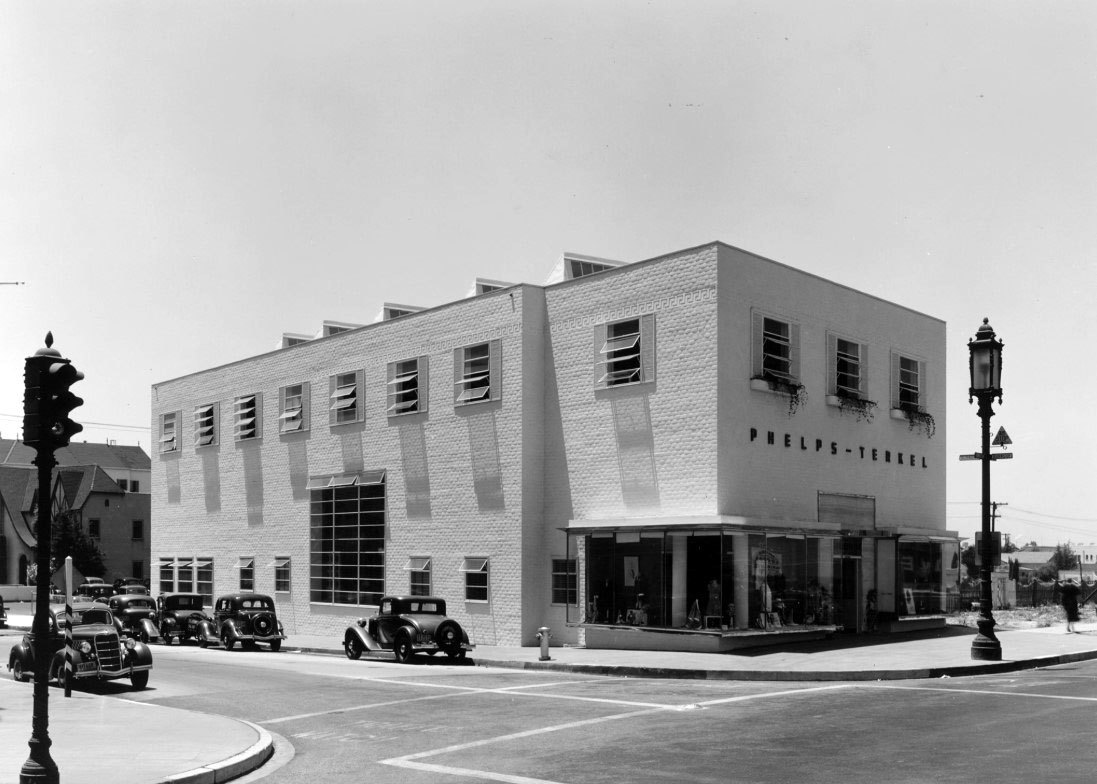 |
|
| (ca. 1936)** - View looking at the SW corner of Wilshire Blvd and Burnside Ave showing the Phelps-Terkel Department Store building. |
Historical Notes Founded in 1923 by Richard B. Terkel and David S. Phelps, Phelps-Terkel was a Los Angeles based department store specializing in men’s clothing. |
.jpg) |
|
| (ca. 1936)** - Close-up view showing the front entrance to the Phelps-Terkel store, 5550 Wilshire at Burnside Avenue. |
Historical Notes In 1965 Phelps-Terkel became part of the Phelps-Wilger chain, based in Westwood; together the new chain had store in: the Miracle Mile, Pasadena, Westwood (2), Sherman Oaks, Newport Beach. Tom Selleck was once a sales clerk at the Sherman Oaks store. In its final years, Phelps-Meager was renamed Phelps, and closed in 1992.*^ The 1936-built Phelps-Terkel department store, designed by Morgan, Walls, and Clements, stood until 2006 when it was demolished to make way for a massive housing complex. |
* * * * * |
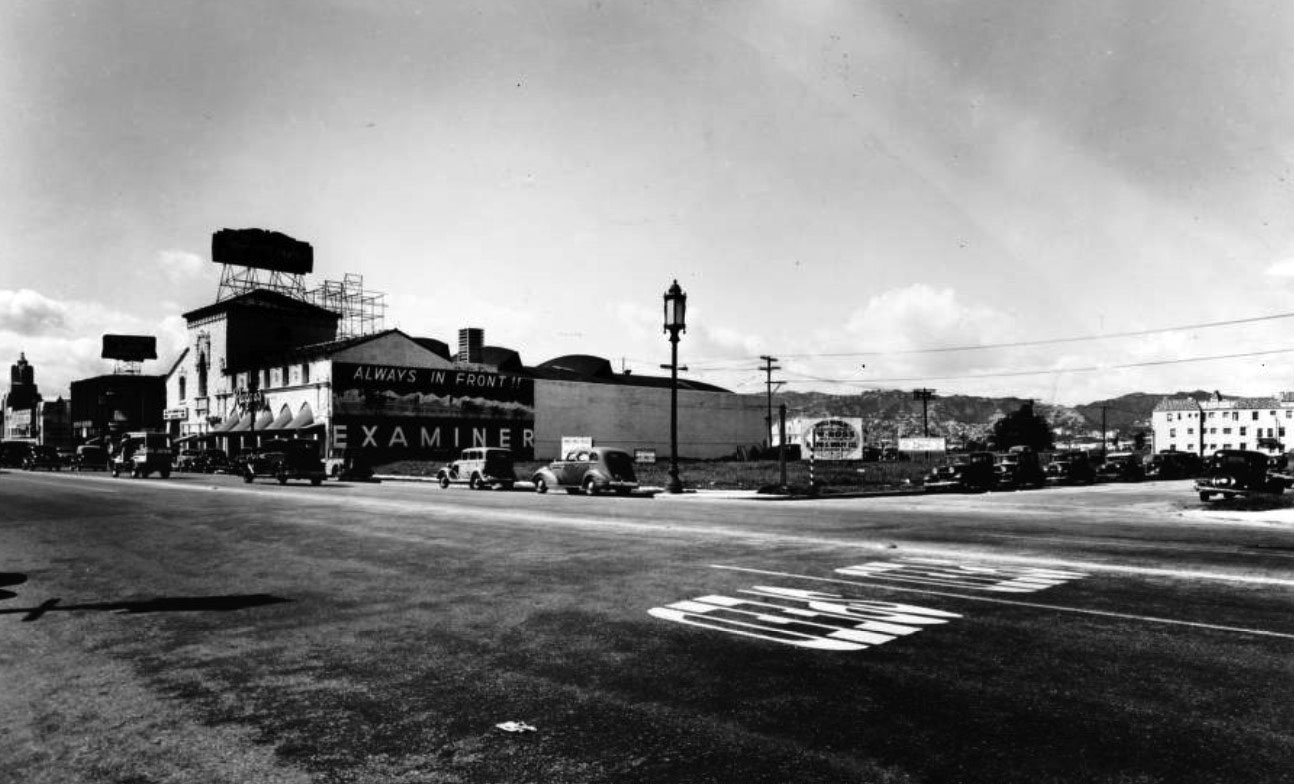 |
|
| (1930s)*# – View looking at the northwest corner of Wilshire Boulevard and Ridgeley Drive. The Ralph’s Market can be seen further west on Wilshire. Click HERE for contemporary view. |
Ralphs Market
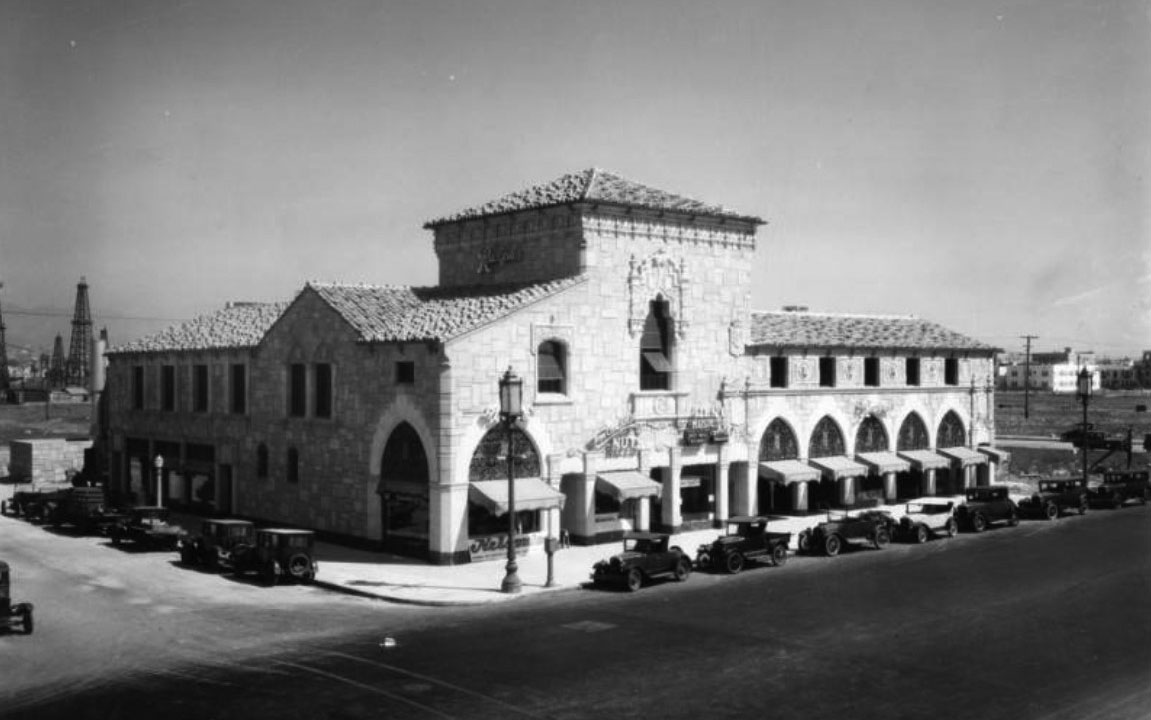 |
|
| (1928)* – View showing Ralphs Market on the NE corner Wilshire and Hauser soon after it opened for business. Note the oil derrick in the distance on the left. |
Historical Notes When the Miracle Mile Ralphs Market was constructed, the neighborhood was full of fallow fields and oil derricks. Clements' design integrated separate commercial spaces into the grocery building for rental tenants, heralding a promising future for the area while giving Ralphs another source of income.^ |
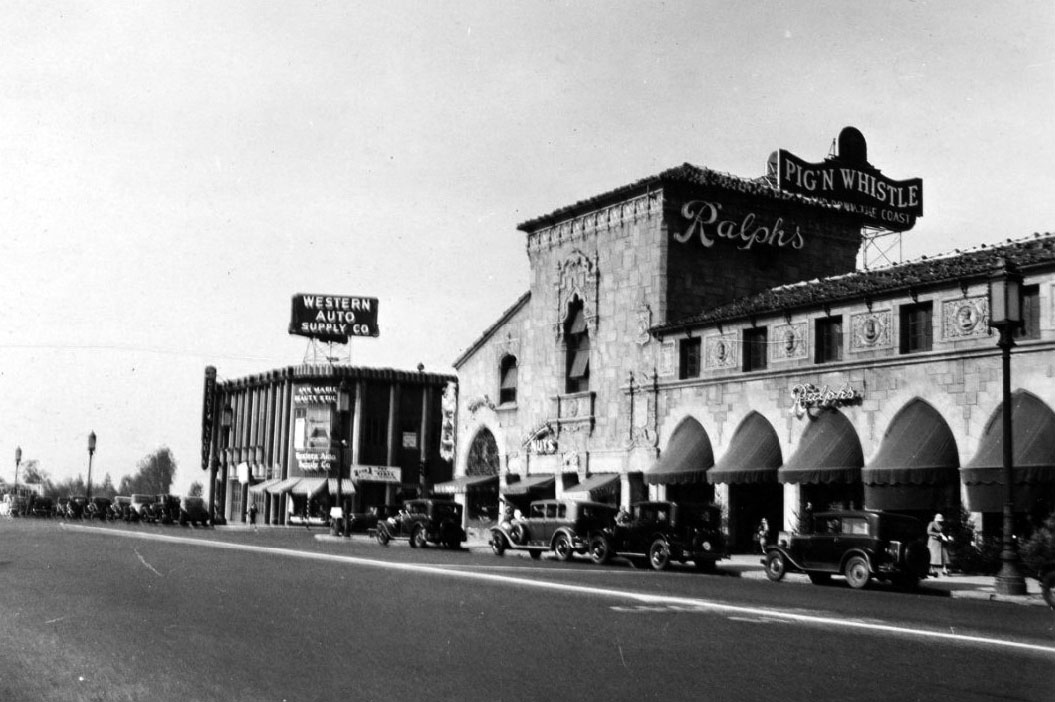 |
|
| (1932)^.^ – View looking northeast on Wilshire toward Hauser showing Ralphs Market on the right with a new Pig’n Whistle sign on top of the building. Western Auto Supply Co. Building can be seen in the distance on the NW corner of Wilshire and Hauser. Click HERE for contemporary view. |
Historical Notes At the time, all the new Ralphs stores were built in the Churrigueresque style popular in Southern California, an ornate Spanish Revival style that architect Stiles O. Clements defined and perfected. Each of the new Ralphs was unique yet similar, exuding strength through large blocks of faux masonry, intricate wrought ironwork, prominent display windows, and Spanish tile roofs.^ The Pig’n Whistle was there from 1929 to 1938, when the Pig’n Whistle company opened its new upscale restaurant, Melody Lane, at Detroit and Wilshire. |
Western Auto Supply Co. Building
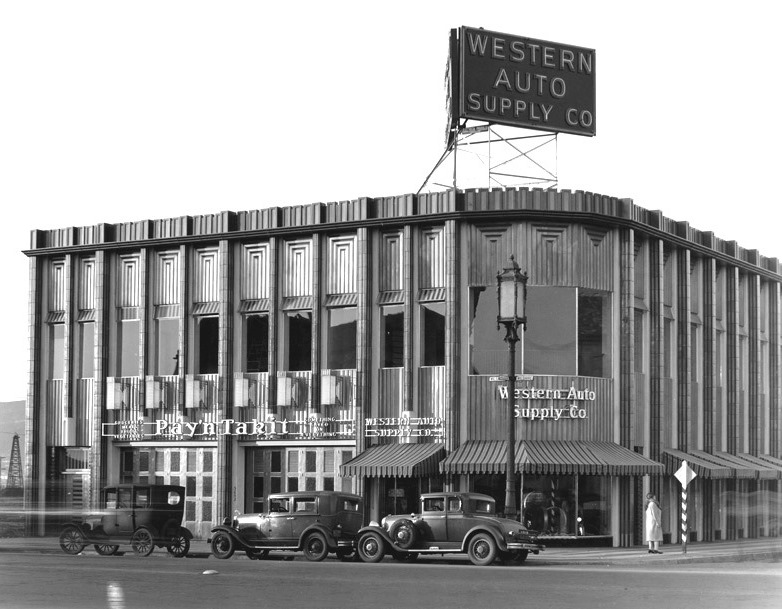 |
|
| (1930s)**#* - View of the Western Auto Parts store at the northwest corner of Wilshire and Hauser Blvds. |
Historical Notes The Western Auto Parts store was designed by Carl Lindbom and completed in 1931. It is the current location of a IHOP restaurant. Click HERE for contemporary view. |
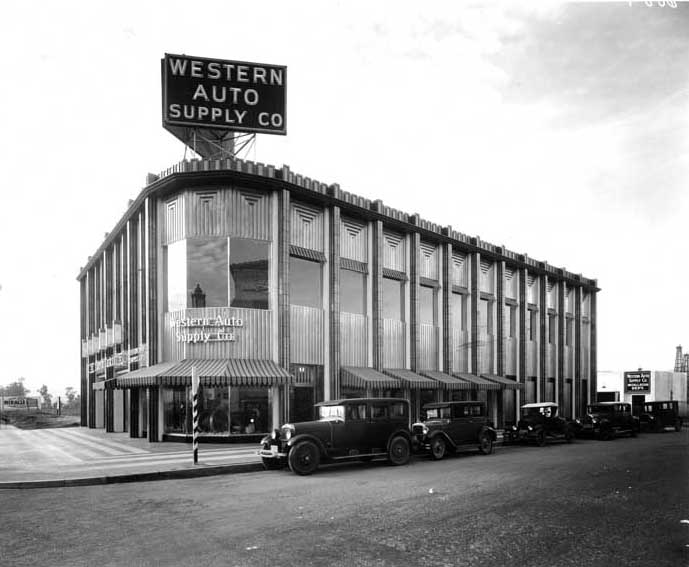 |
|
| (1930s)^*# - View of the northwest corner of Wilshire and Hauser showing the Western Auto Supply Co. Building. Several cars are seen parked on Hauser Blvd. |
Historical Notes In 1909, at the age of twenty-three, George Pepperdine started Western Auto Supply Company in Kansas City, Missouri, with an initial investment of five dollars. With the rise in popularity of the automobile, Pepperdine's business thrived, providing high-quality automotive products and services through many retail stores. He moved to California in 1916 where he became extremely successful as his business continued to grow. In 1937, during the Great Depression, he founded Pepperdine University as a Christian liberal arts college in South Los Angeles. The school expanded to Malibu in 1972.^ |
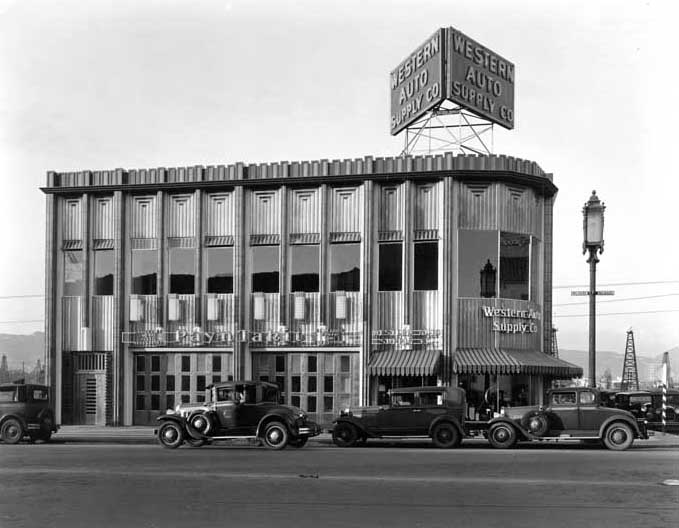 |
|
| (1930s)^*# - View looking north of the Western Auto Supply Co. Building located at 5655 Wilshire Boulevard. A tall "Wilshire Special" streetlight stands on the corner (Wilshire and Hauser). In the distance also stands an oil derrick. Click HERE to see more Early L.A. Streetlights. |
Then and Now
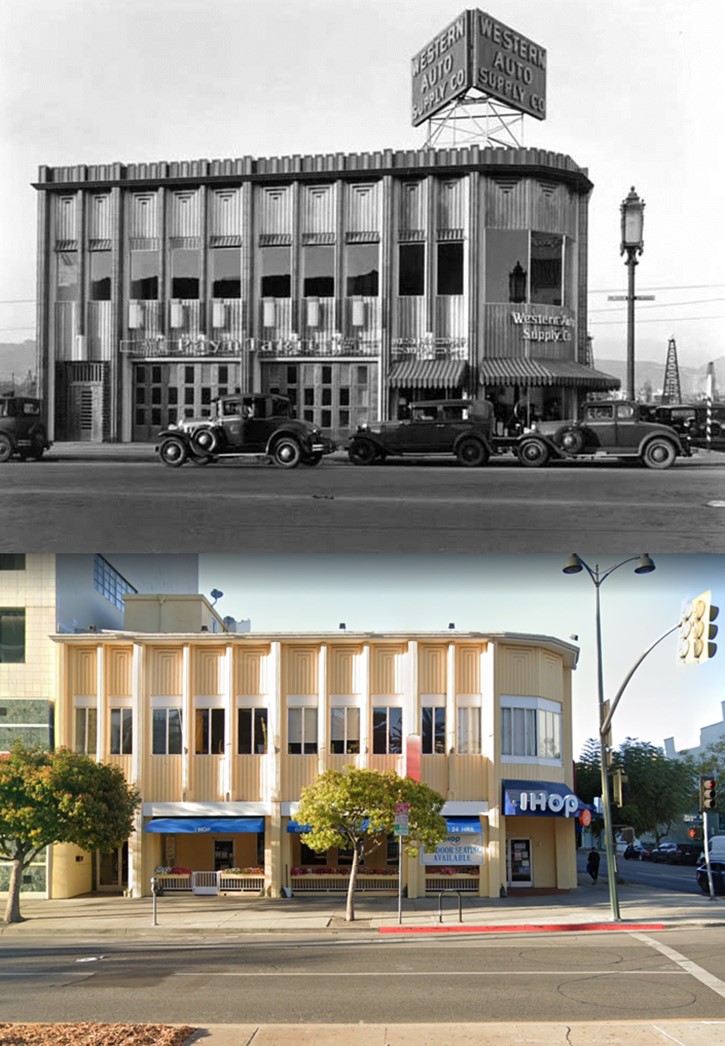 |
|
| (1931 vs. 2021)* - Western Auto Supply Co. Building, currently an International House of Pancakes (IHOP) restaurant. |
* * * * * |
Wilshire and Fairfax
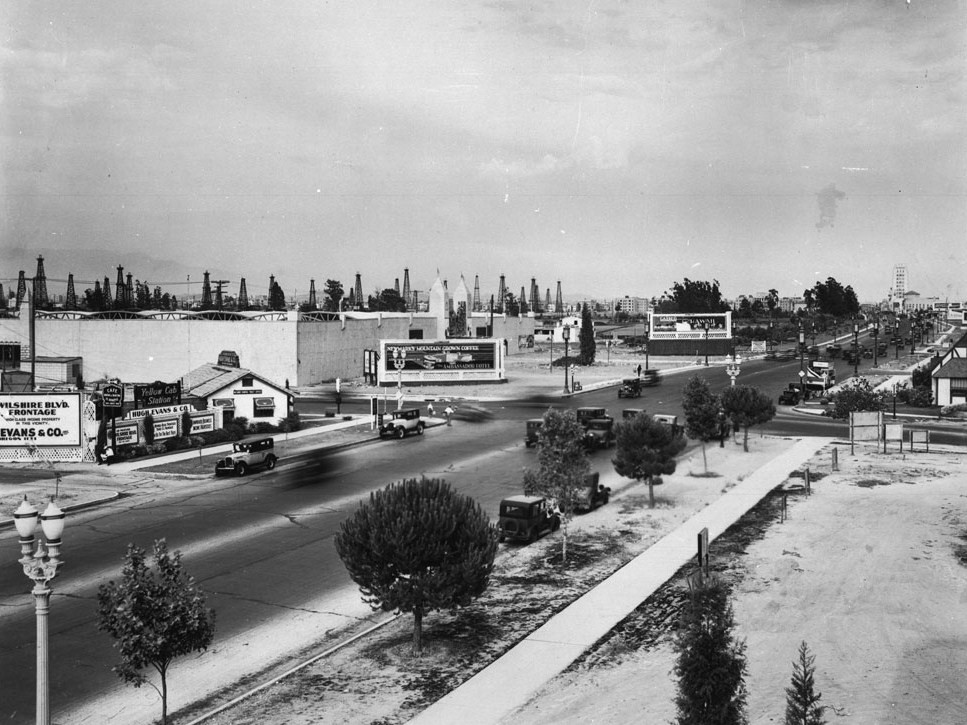 |
|
| (ca. 1929)*# - View looking east on Wilshire Boulevard toward its intersection with Fairfax Avenue. The northeast corner with the billboard is where the May Company Department Store would go about 10 years later. On the opposite corner (NW corner) where the little white house is, was once Rogers Airport, and would later become the iconic circular Simon's Drive-in restaurant. It is now the Johnies 50s diner. Oil wells are spread out where Park La Brea is now. |
Historical Notes In the late 1930s the 1.5-mile stretch of Wilshire Boulevard between Fairfax and Highland Avenues would be named the Miracle Mile. |
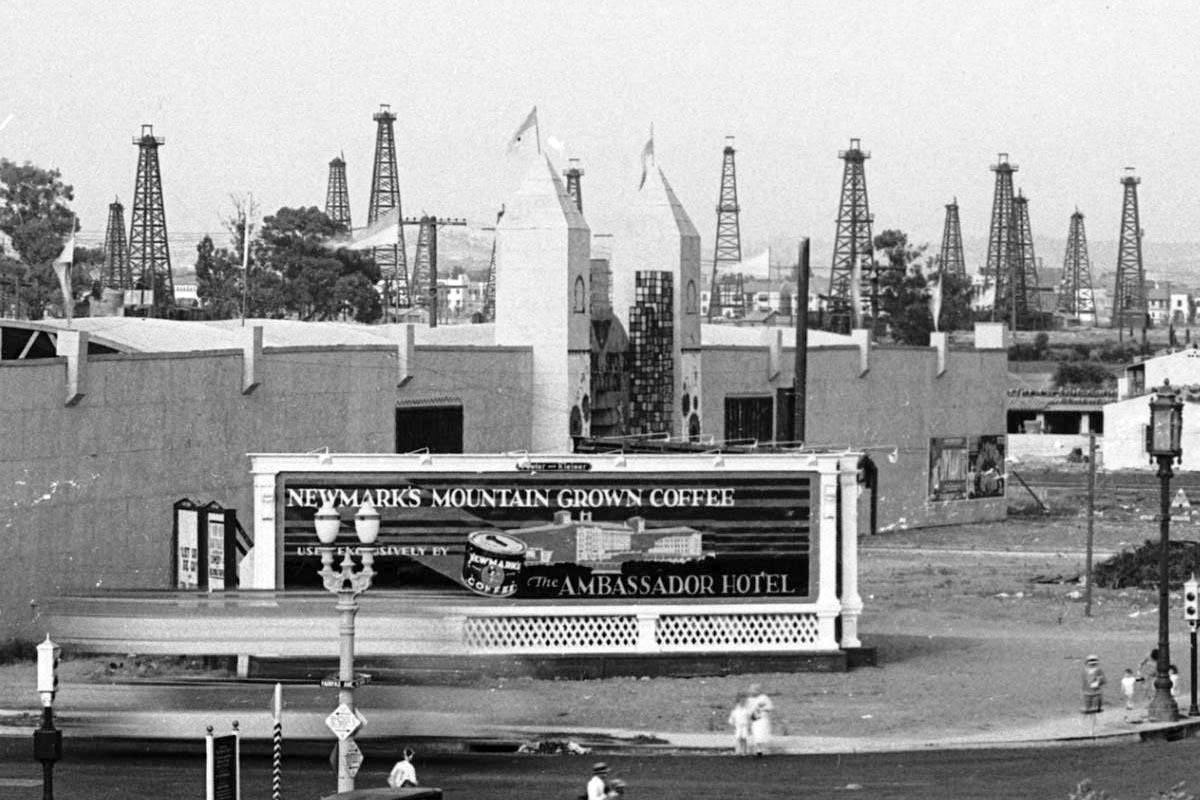 |
|
| (ca. 1929)*# – Close-up view of the northeast corner of Wilshire and Fairfax with an unusual shaped building located at the future site of the May Company Building. Signboard in the foreground reads “Newmark’s Mountain Grown Coffee Exclusively Served by the Ambassador Hotel”. Note all the oil derricks in the background. |
Historical Notes In the 1890s, dairy farmer Arthur F. Gilmore found oil on his land, probably in the vicinity of the La Brea Tar Pits. The field was named after the Salt Lake Oil Company, the first firm to arrive to drill in the area. The discovery well was spudded (started) in 1902. Development of the field was fast, as oil wells spread across the landscape, with drillers hoping to match the production boom taking place a few miles to the east at the Los Angeles City field. Peak production was in 1908. By 1912, there were 326 wells, 47 of which had already been abandoned, and by 1917 more than 450, which had by then produced more than 50 million barrels of oil. After this peak, production declined rapidly. Land values rose, corresponding to the fast growth of the adjacent city of Los Angeles, and the field was mostly idled in favor of housing and commercial development. The early wells were abandoned; many of their exact locations are not known, and are now covered with buildings and roads.^* |
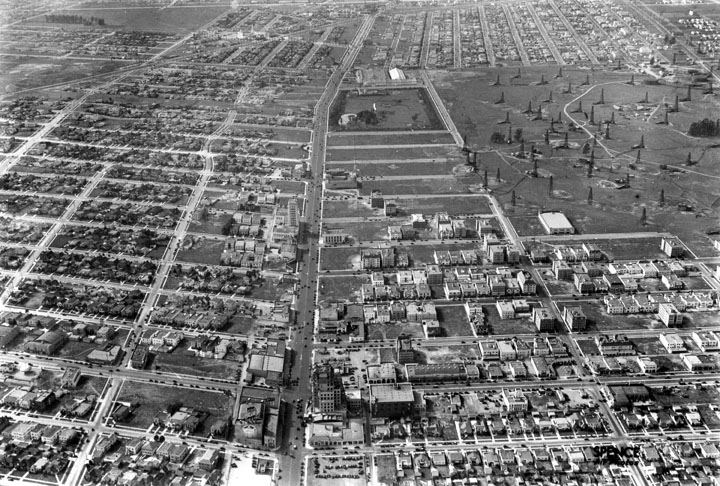 |
|
| (1930)^ - Aerial view looking west down Wilshire Boulevard from above Sycamore. The widest street visible, Wilshire, became known as the Miracle Mile, where most high rises were built through the years. The Salt Lake Oil Field is at upper-right and the La Brea Tar Pits at upper-center. Fairfax runs horizontal at top of photo at the end of the oil field. Farmers Market is out of view in the upper-right. |
Historical Notes Developer A.W. Ross foresaw a grand commercial destiny for western Wilshire Boulevard earlier than anyone else. In the early 1920s, Ross began buying up land along Wilshire Boulevard between La Brea Avenue and Fairfax Avenue, a pursuit some referred to as “Ross’s Folly.” He envisioned a destination shopping district that would lure customers from Beverly Hills as well as Hollywood and downtown Los Angeles, and encouraged the construction of architecturally distinctive commercial buildings. Ross’s development gamble along the western part of Wilshire Boulevard paid off in spades from the late 1920s and through the 1930s, as “Ross’s Folly” became known as Miracle Mile. The area housed large retailers like Desmond’s, Silverwoods, and the May Company, and even supermarkets like Ralph’s boasted flashy architecture on a grand scale. Ross remained a major force in the development of Wilshire Boulevard until the 1960s, seeing the boulevard lure the city’s population ever westward. |
Click HERE to see more Early Views of the Miracle Mile (1940s & 1950s). |
* * * * * |
Please Support Our Cause Water and Power Associates, Inc. is a non-profit, public service organization dedicated to preserving historical records and photos. Your generosity allows us to continue to disseminate knowledge of the rich and diverse multicultural history of the greater Los Angeles area; to serve as a resource of historical information; and to assist in the preservation of the city's historic records. |
For more Historical Los Angeles Views click one of the following:
For Other Historical Views click one of the following:
See Our Newest Sections:
To see how Water and Electricity shaped the history of Los Angeles click one of the following:
Water:
Power:
* * * * * |
References and Credits
* DWP - LA Public Library Image Archive
^ LA Public Library Image Archive
*^Oviatt Library Digital Archives
^^LA Times: Photo Archive; An Oil Well on La Cienega; Mulholland Bridge; A Mountain of Red Cars; The Vincent Thomas Bridge; Hill Street Tunnels; Harbor-Santa Monica Freeway Interchange; Dodgers Caravan,1958
#*MTA Transportation and Research Library Archives
+#Facebook.com: Garden of Allah Novels
#^^Picturetrail.com: KCET - Angels Flight
#^*Downtown LA Public Art: Fort Moore Pioneer Monument
^**Flickr: Enock 1; Eric Richardson
*^#Los Angeles Conservancy: LA Stock Exchange Building; Park La Brea
^#^Pacific Electric Railway Historical Society - Alan Weeks Collection
*#*Westland.net: Venice History
*#^Forum.Skyscraper.com: Arroyo Seco Library; Westwood-Life Magazine; North Los Angeles Street
^#*Metro.net: Mulholland Drive Bridge
**#The California History Room, California State Library: William Reagh
#**Pinterest - California and DailyBreeze.com
#^#Deadhistoryproject.com: Silent Movie Theater
+**Los Angeles' Bunker Hill - Alta Visa Apartments
+##MartinTurnbull.com: Fairfax and Wilshire
^^+How Stuff Works: Chevrolet Impala
+#+Pinterest - California and DailyBreeze.com; Mid Century Hollywood
++#Facebook.com: Photos of Los Angeles
^^#The George A. Eslinger Street Lighting Photo Gallery
^^*Early Downtown Los Angeles - Cory Stargel, Sarah Stargel
***Los Angeles Historic - Cultural Monuments Listing
*^*California Historical Landmarks Listing (Los Angeles)
*^^Nuestra Señora la Reina de los Ángeles: losangelespast.com
**** Pinterest.com: Los Angeles Dodgers; Los Angeles and Hollywood; MacArthur Park w/Downtown Skyline; Gilmore Self-Service Gas Station
**^*California State Library Image Archive
**^#Vintage Los Angeles: Facebook.com - Gilmore Stadium and Field; Cruising Hollywood Blvd
^^^^Depaul.edu: Night Train 55
**#^Vincent Thomas Bridge - Facts and Figures
*#**Flickr-Los Angeles in Good Light - Ron Reiring
^#^^Flickr.com: Michael Ryerson
*#^#Life.time.com: Stoked-Life Goes Surfing
^#^#Pinterest: Bygone Los Angeles
*#*#Abandoned & Little-Known Airfields – Paul Freeman
^#*#LA Magazine: Beverly Park Ponyland
^^##Pacific Electric Railway Historical Society
^^*#Historic LA Theatres: Downtown Broadway Theatres
^^#*LA Observed.com: Decommissioned Street Cars; Bunker HIll, 1964
*^^*Pinterest.com: Bertrand Lacheze
^^**Pinterest.com: Vintage California
^^++Huntington Digital Library Archive
*##*Pinterest.com: Trucks, Pick-Ups, and Gas Stations
*##^LAist.com: Harbor Freeway, 1969; Century Plaza Hotel
##*^Port of Los Angeles: portoflosangeles.corg
##^*Calisphere: University of California Image Archive
##^^Cinema Treasures: Olympic Drive-In
#**#California State University Northridge History: csun.edu
#++#The Pacific Electric Railway Historical Society (PERyHS)
#*##Daily News: Mulholland Bridge
#^**The Go Go's: N/W Corner of Hollywood and Vine
#^*#Flickr.com: Paul Bajerczak
##^#Facebook.com: Classic Hollywood-Los Angeles-SFV
^***UCLA Library Digital Archive
^^^*KCET: Welcome to L.A. River; Four Level Interchange; Construction of 5 Southern California Freeways; Beverly Park and Ponyland; Before the 'Carmageddon': A Photographic Look at the Construction of 5 SoCal Freeways; Seventh and Broadway; L.A.'s First Freeways
****^Facebook.com: West San Fernando Valley Then And Now
*^^^^Los Angeles Maritime Museum
^^^**tumblr.com: John Ferraro Office Building; DWP Office Building
**^^^Facebook.com - San Pedro's Original Website, San Pedro.com
#*#**Facebook.com: Beverly Park - L.A.'s Kiddieland
**#**LMU Digital Archive
**^ Noirish Los Angeles - forum.skyscraperpage.com; Westwood-Life Magazine; Selling Papers on Olive; California Federal Plaza Building; Downtown Aerial 1958; 1949 Construction of 101 Freeway; 1953 Harbor Freeway Construction; Wilshire Blvd, 1949; Zephyr Room and Brown Derby Postcard View; Aliso Before and After 101 Frwy; Vincent Thomas Bridge; Gilmore Aerial; Hollywood Frwy Traffic Jam; 2012 Downtown Skyline; View from GOB; Bonaventure Hotel Aerial; Hollywood and Vine
^* Wikipedia: Hollywood Sign; Carthay Circle Theatre; Fairfax High School; Park La Brea; San Vicente Boulevard; Etymologies of place names in Los Angeles; Los Angeles Central Library; Broadway Tunnel; Pershing Square; Pacific Electric Railway; Gilmore Field; GilmoreStadium; Union Station; Westwood; 6th Street Viaduct Bridge; Figueroa Street Tunnels; Chavez Ravine; 2nd Street Tunnel; Hollywood Freeway; Los Angeles International Airport; Los Angeles City Hall; Wilshire Boulevard Temple; Egyptian Theatre; The Pig 'N Whistle; Sunland-Tujunga; Van de Kamp Bakery Building; Los Angeles County Art Museum; Los Angeles City Oil Field; Los Angeles Railway; Miracle Mile; Interstate 405; Chevrolet Impala; Playa Vista; Harbor Frwy (Interstate 110); History of Los Angeles Population Growth; Los Angeles City Hall Lindbergh Beacon; May Company California; Four Level Interchange; California Federal Bank; Harbor Freeway; Arroyo Seco Parkway; Brown Derby; 2004 Los Angeles Skyline; LA's Oldest Palm Trees; Vincent Thomas Bridge; World Cruise Center; CSUN; Westwood; Westwood Village; UCLA; History of UCLA; 1950s Americal Automotove Culture; Pershing Square; Century Plaza Hotel; California Incline
< Back
Menu
- Home
- Mission
- Museum
- Major Efforts
- Recent Newsletters
- Historical Op Ed Pieces
- Board Officers and Directors
- Mulholland/McCarthy Service Awards
- Positions on Owens Valley and the City of Los Angeles Issues
- Legislative Positions on
Water Issues
- Legislative Positions on
Energy Issues
- Membership
- Contact Us
- Search Index
